Pacific Northwest
Creeping Honeysuckle

Name: Lonicera crassifolia
Zones: 6–9
Size: 5 inches tall and 5 to 7 feet wide
Conditions: Full sun to partial shade; moderately moist, well-drained soil
Native range: China
This plant is so good that whenever I see it at a nursery, I can’t resist telling everyone around me about its unique selling points. Plant it in a large container, hanging basket, or window box and its tiny, round evergreen leaves will cascade down the side. Plant it as a ground cover and it will slowly scramble around other plants, hence the common name creeping honeysuckle. The unscented, tube-shaped flowers start out pink and chartreuse, then age to creamy yellow orange. There are generally multiple flowers in different stages of bloom on a plant, creating a kaleidoscope of all the colors happening at once. The leaves sometimes turn purple red in the colder months, possibly as a reaction to both colder temperatures and drier soil.
Williams Rhododendron
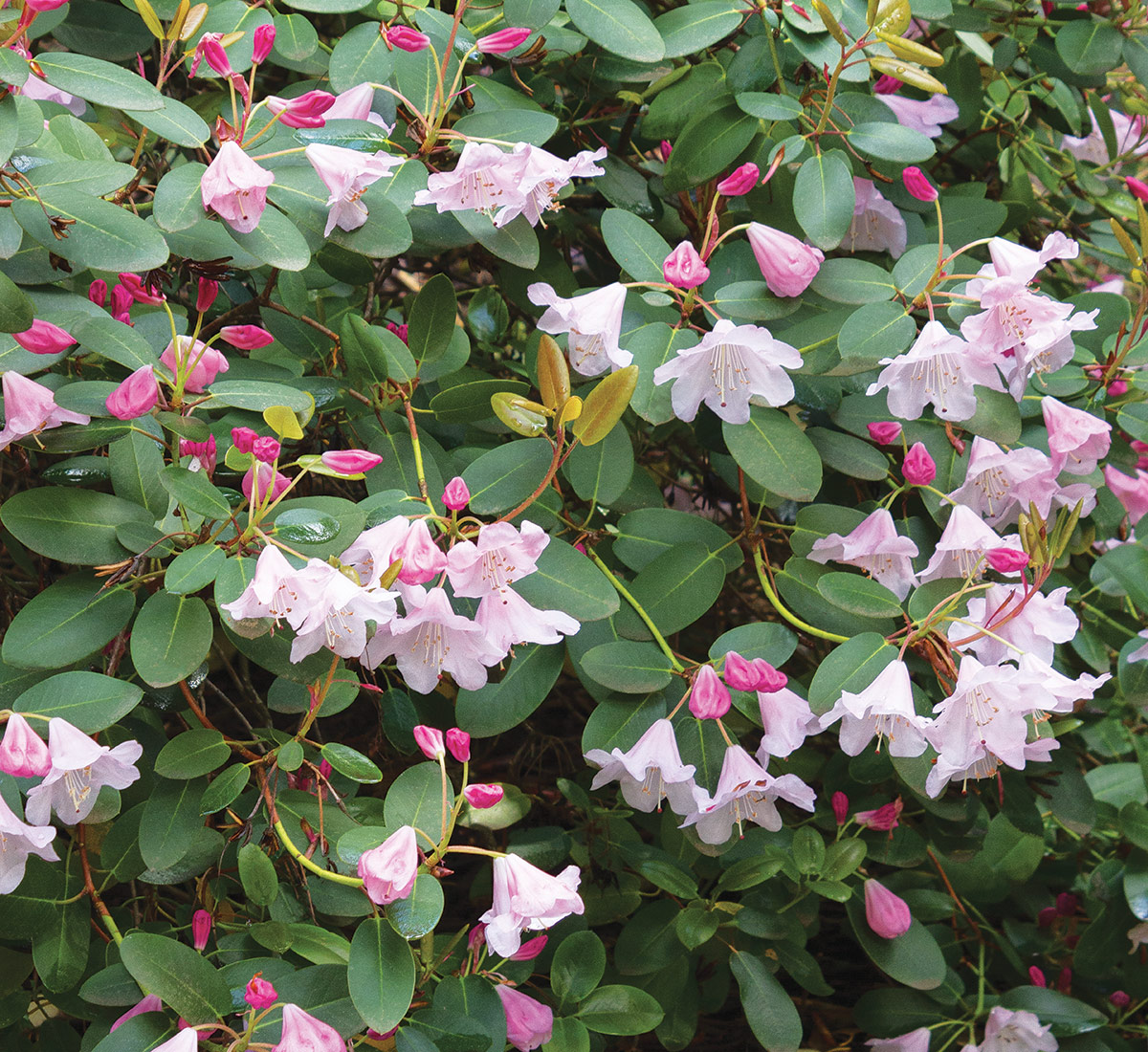
Name: Rhododendron williamsianum
Zones: 6–9
Size: 16 to 24 inches tall and wide
Conditions: Full sun to partial shade; evenly moist, acidic soil
Native range: Sichuan, China
Rounded leaves (ovate-orbicular, to be precise) and shiny bronze new growth make this an attractive addition to any planting. In fact, people are often shocked to learn that it is a rhododendron. Light pink, downward-facing, bell-shaped flowers appear in spring, although I’ve successfully prevented my plants from flowering by growing them in shadier conditions. Yes, you read that right—I don’t want flowers. The foliage is what I love about this plant. There appears to be a larger form of Williams rhododendron, sometimes found in older gardens, that can grow up to four or five feet tall and wide, but this one should stay under two feet tall for at least its first 10 years. Though it can be a little challenging to track down, the hunt is half the fun.
‘Magenta Magic’ Yucca
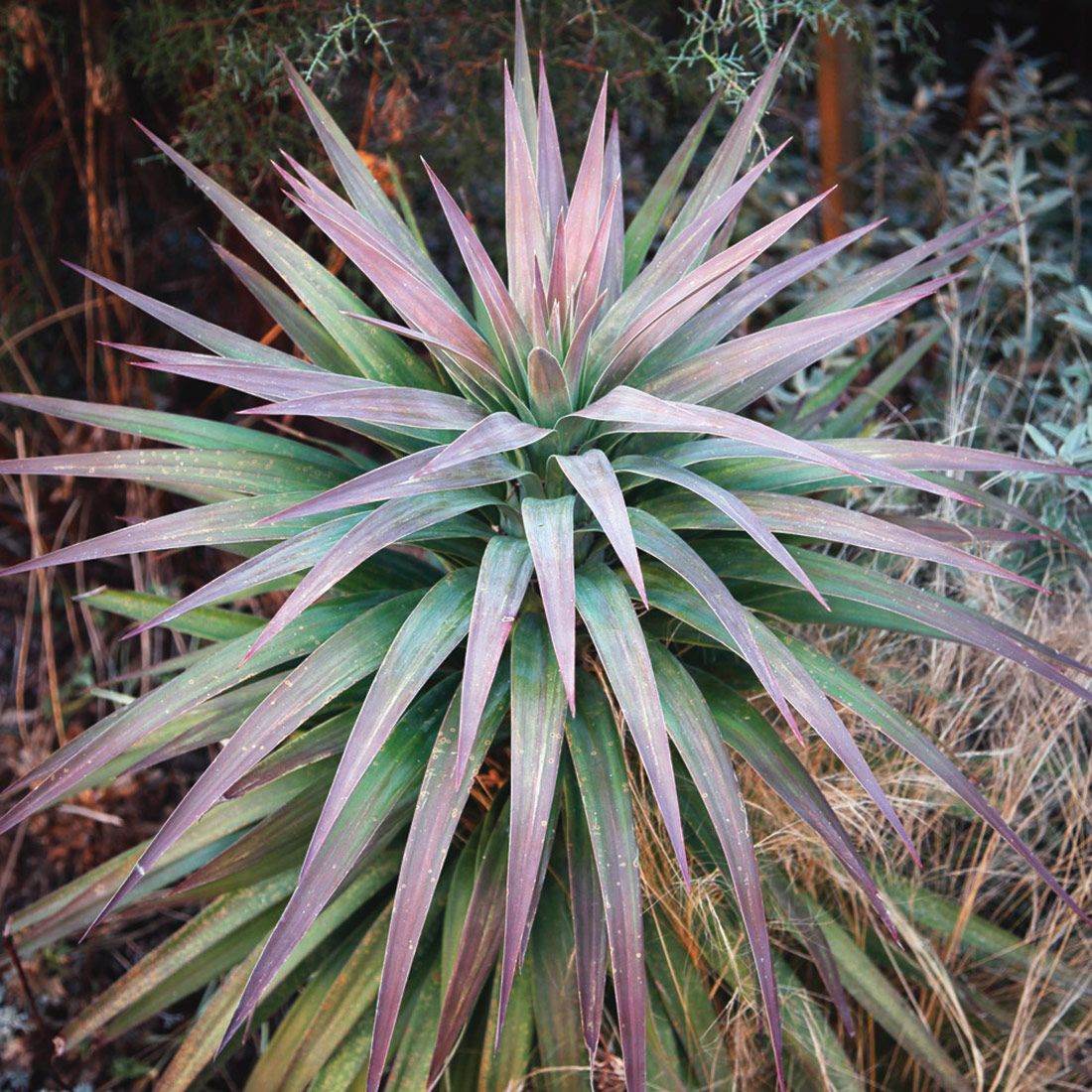
Name: Yucca aloifolia ‘Magenta Magic’
Zones: 7–9
Size: 24 inches tall and 12 inches wide
Conditions: Full sun; average to dry, well-drained soil
Native range: Southeastern United States
Finally, I have found a purple-leafed yucca that actually lives through winter in my Portland garden. I’ve planted more ‘Blue Boy’ yucca (Y. aloifolia ‘Blue Boy’, Zones 8–10) than any sane person would, each time falling for that fantastic foliage color and praying that this will be the one that finally lives. Sadly, they never make it to spring. There are no such worries with ‘Magenta Magic’. Some sources describe the dark leaf color as the plant’s reaction to cool nights, but as long as my plants receive adequate sun and a little drought stress, they have hung on to their warm purple color year-round. Spanish dagger, the common name, hints at just how dangerous yuccas can be when planted near a pathway, but this also means they can be used to deter unwanted visitors.
Fine Line® Buckthorn
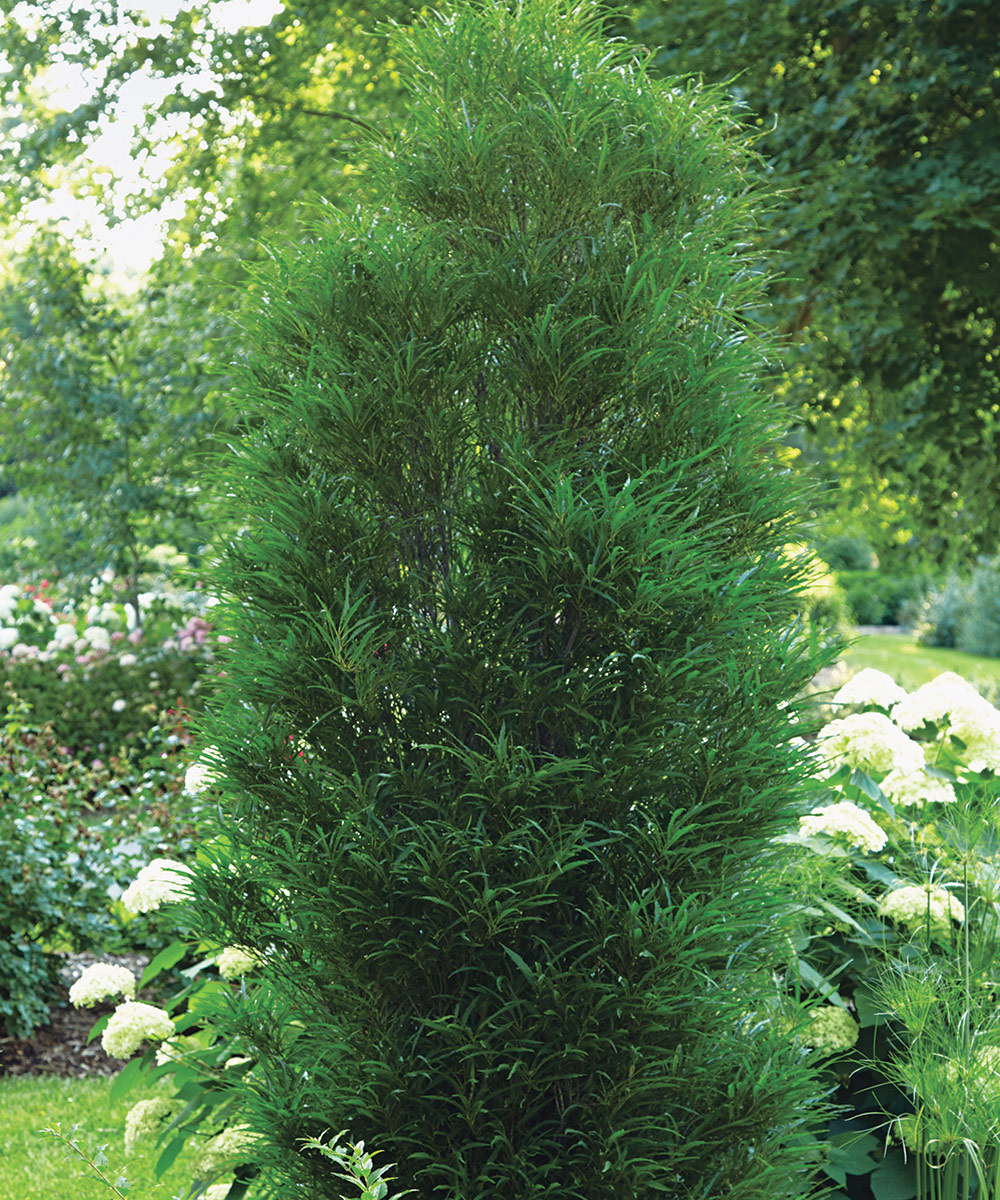
Name: Rhamnus frangula ‘Ron Williams’
Zones: 3–9
Size: 6 to 10 feet tall and 2 to 3 feet wide
Conditions: Full sun to partial shade; adaptable to most soil types
Native range: Europe and western Asia
The ferny foliage of this narrow, columnar shrub adds an unusual soft texture to a garden bed. In late autumn, the thin leaves turn golden yellow before dropping to reveal dark stems. The older bark retains its dark color but develops creamy-colored speckles, adding another layer of interest. In late spring, small, pale green flowers provide contrasting texture and are sometimes followed by pea-sized fruit in shades of red to purplish black. The seeds are mostly nonviable, so this is not an invasive form of buckthorn, and it is quite drought tolerant when established. Use the upright, slender form of Fine Line® as an exclamation point in a foundation planting, where it will add height without blocking windows or access to the house. My husband painted behind ours with no complaints, and that’s saying something!
Regional expert: Loree Bohl is a lover of spiky plants, the creator of the Danger Garden blog, and the author of Fearless Gardening: Be Bold, Break the Rules, and Grow What You Love.
Southwest
Pawnee Buttes® Sand Cherry
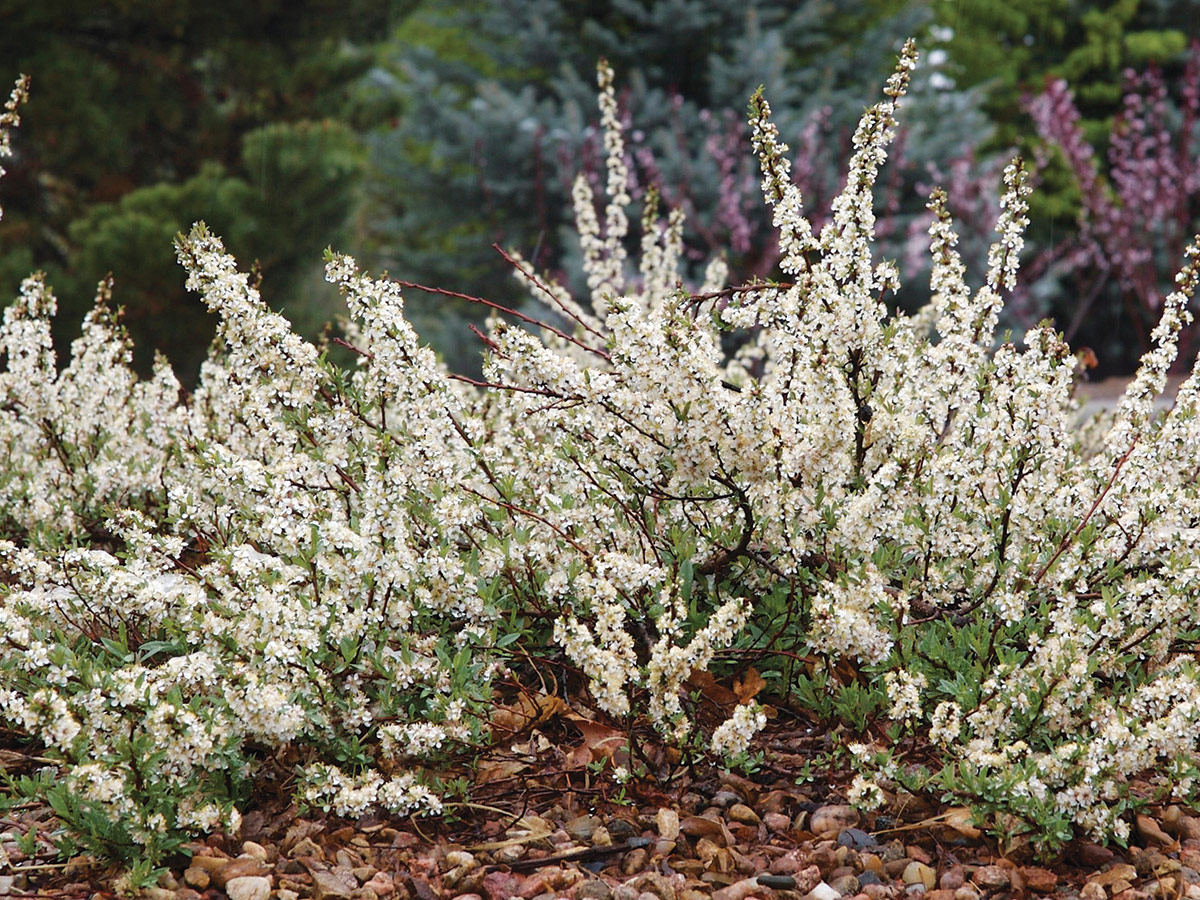
Name: Prunus besseyi ‘P011S’
Zones: 3–8
Size: 15 to 20 inches tall and 4 to 6 feet wide
Conditions: Full sun to partial shade; adaptable to a wide range of soil types
Native range: Central and western U.S. and Canada
This shrubby selection from our native sand cherry was discovered in the Pawnee Grasslands of northeastern Colorado. It has a charming and cascading habit upon maturity, with glossy, narrow, green leaves that are smothered with fragrant, white flowers in early spring. In April it is a pollinator magnet. Give Pawnee Buttes® room to spread, and consider massing several plants for a showy display near a wall or building. In fall its burgundy foliage is a genuine perk to the landscape and it produces a heavy crop of purplish-black fruits that birds love. I have this deer-resistant beauty planted close to my mailbox, where it rarely needs water.
Dwarf Leadplant
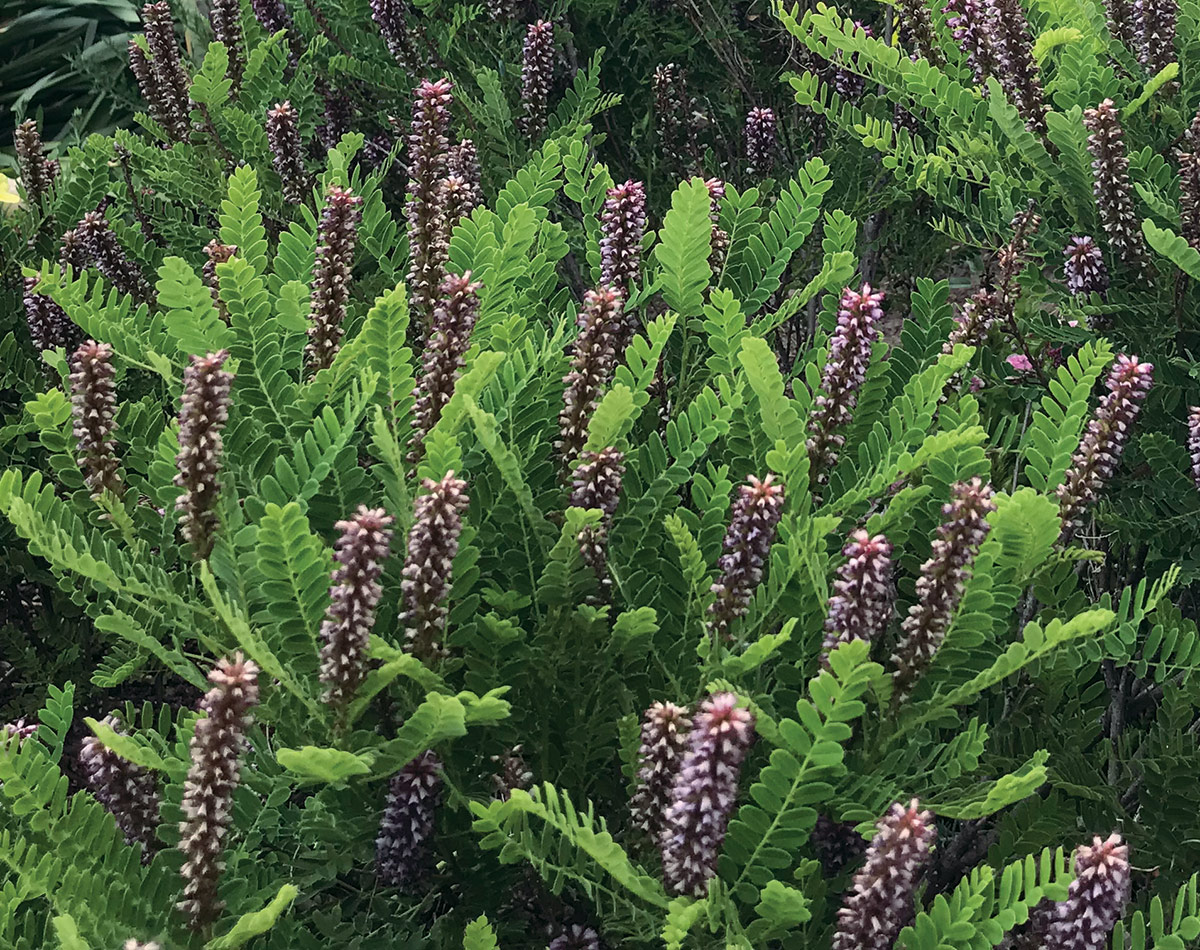
Name: Amorpha nana
Zones: 3–7
Size: 2 to 3 feet tall and wide
Conditions: Full sun to partial shade; average to dry, well-drained soil
Native range: The Great Plains
Dwarf leadplant called to me at a plant sale with its unusual name, unique appearance, and suitability for a challenging spot. I’m always thrilled in late spring when small buds emerge against its fine-textured mound of leaves in my sunny rock garden. Soon after, leadplant will produce dozens of purple spires that are a few inches long and tinted nearly orange in full sun. The showy, honey-scented flowers are loved by bees and butterflies. As summer progresses and nearby perennial flowers fade and look unkempt, this bushy specimen stays packed with pliable, healthy greenery for months. Just before snow arrives in the more northern parts of our region, the thin leaves will turn an attractive yellow.
Rubber Rabbitbrush
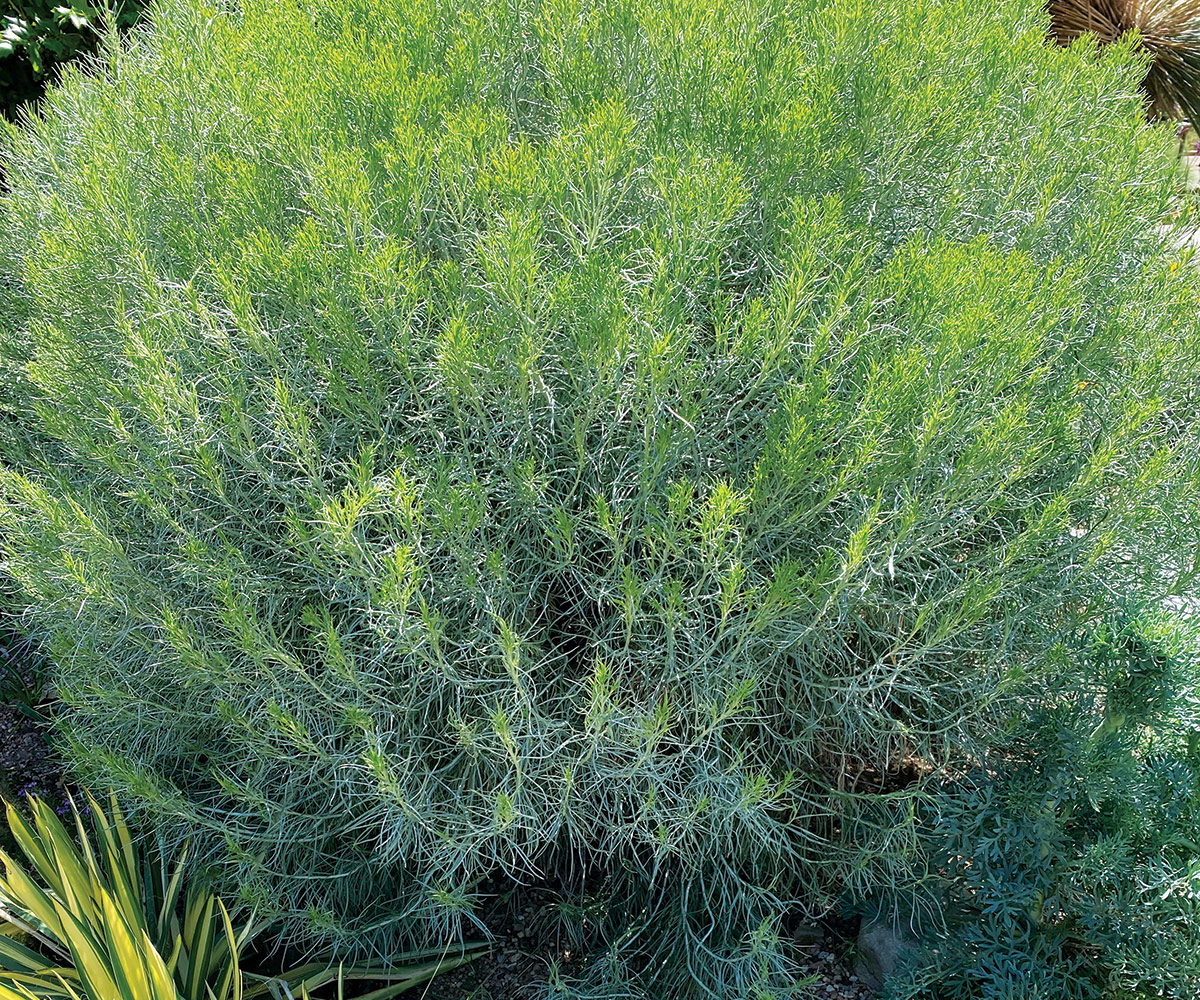
Name: Ericameria nauseosa var. nauseosa
Zones: 4–9
Size: 18 to 24 inches tall and 20 to 30 inches wide
Conditions: Full sun to partial shade; average to dry, well-drained soil
Native range: Western North America
The bluish-gray foliage of rubber rabbitbrush is held in a dense, domed shape that is topped with clusters of bright golden flowers from late summer through fall. This butterfly favorite has a strong fibrous root system that contributes to its water efficiency. It’s a pleasure to run your fingers through its thin, soft leaves, which exude a pleasant aroma, especially after a rainfall. Shear off about a foot of top growth in late winter or early spring to encourage improved branching and increased flower production and to help it keep its tidy, symmetrical shape. This tough plant endures wind and cold and is a staple for dry locations once established.
Little Mountain Mahogany
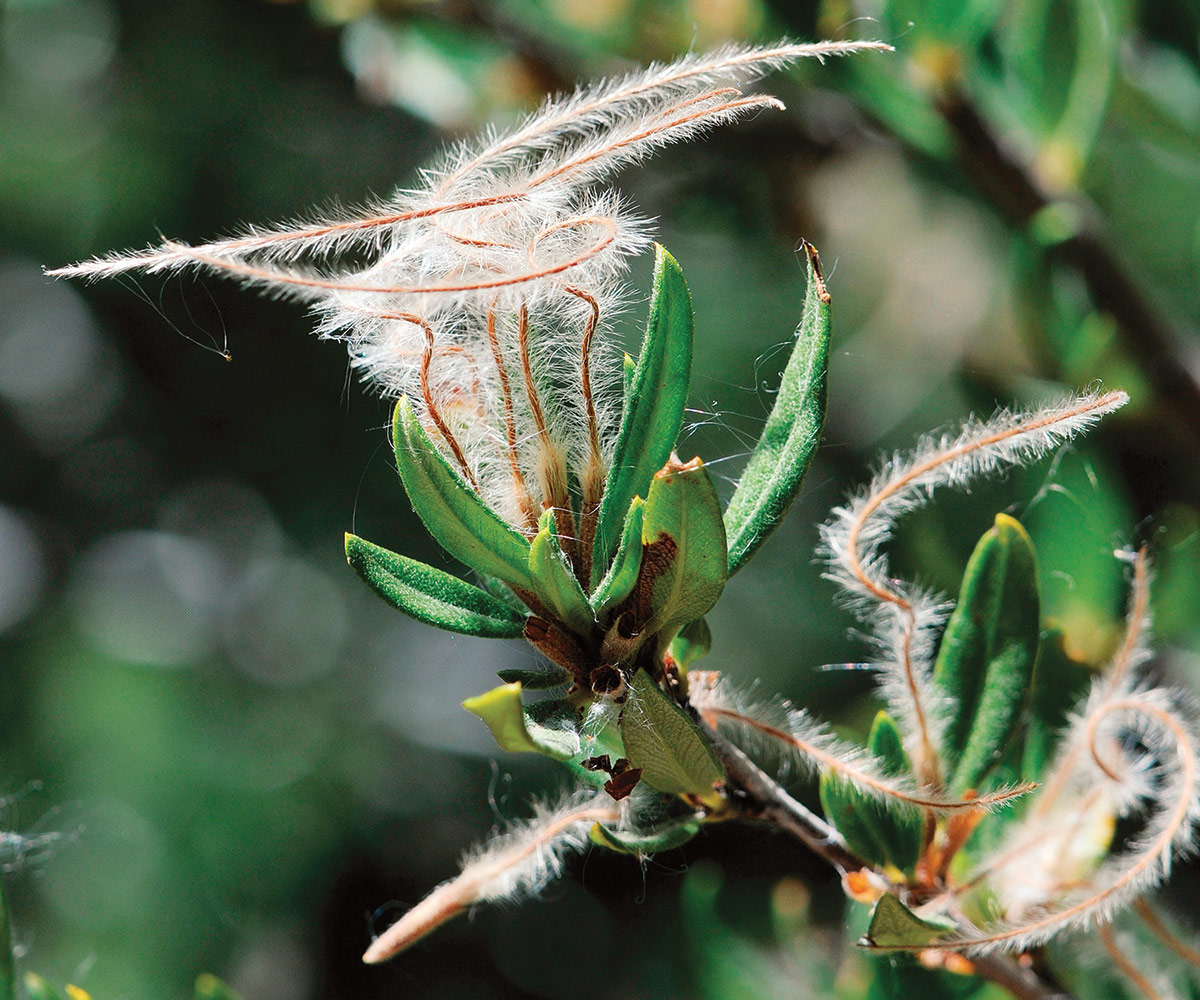
Name: Cercocarpus intricatus
Zones: 3–9
Size: 4 to 5 feet tall and 3 to 4 feet wide
Conditions: Full sun; adaptable to most soil types
Native range: Southwestern U.S.
This slow-growing, broadleaf evergreen with intricately branching stems will flourish in even the harshest conditions, making it a perfect fit for our gardens. It takes about two years to get established, after which it is nearly carefree. Littleleaf mountain mahogany succeeds as a hedge or specimen plant, and its silvery-green foliage provides appealing year-round interest. In mid-spring it is covered in plumes of tiny greenish-yellow flowers that transform when they are pollinated by small native bees, developing feathery seed tails that catch the afternoon light (pictured). It is an excellent nectar source for pollinators and provides good bird habitat too. As the shrub matures, it can be pruned or sheared to the desired shape easily.
Regional expert: Marilyn Raff is a poet, painter, and writer who gardens on a small city lot in the high desert.
Mountain West
Fernbrush
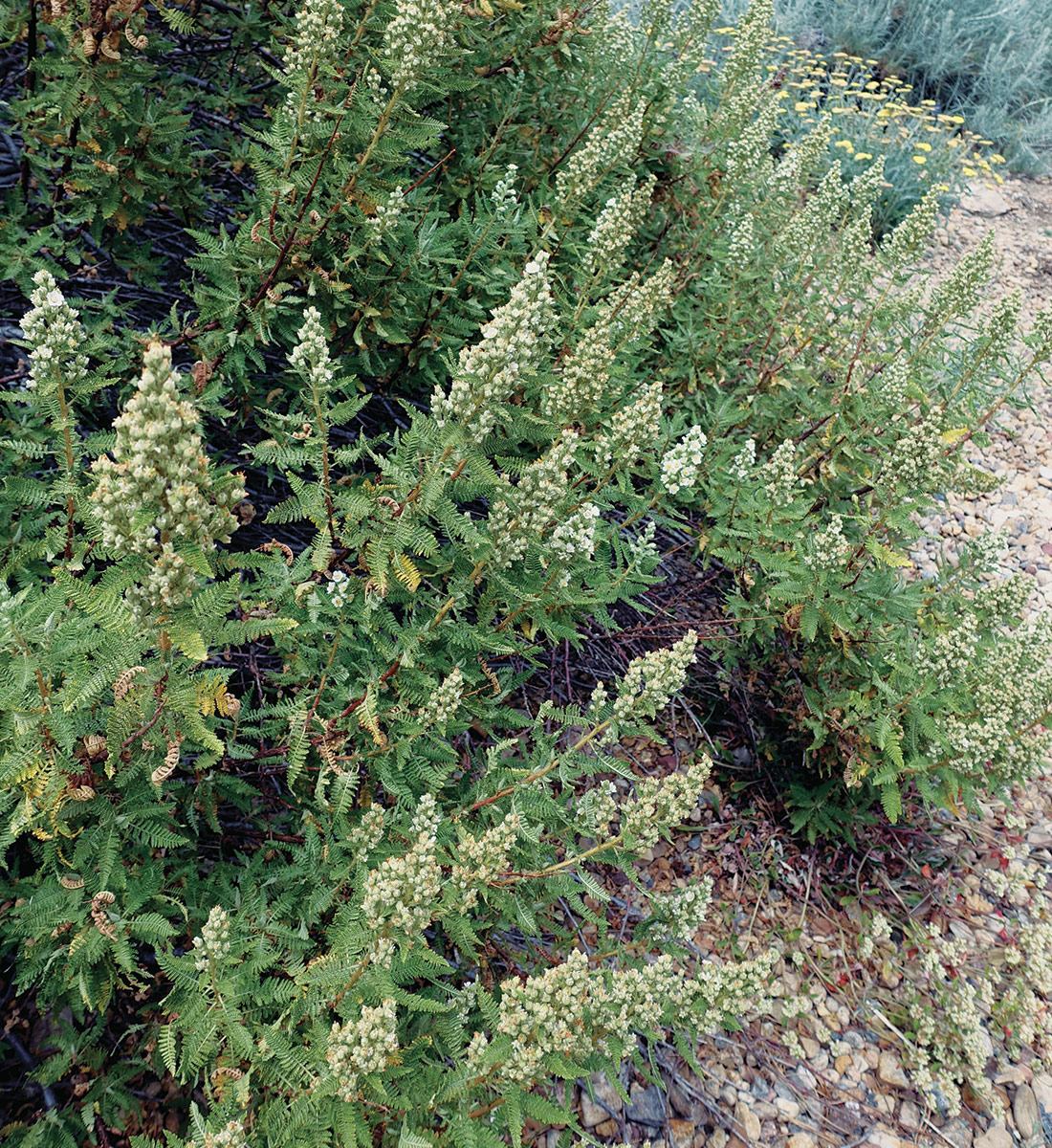
Name: Chamaebatiaria millefolium
Zones: 4b–8
Size: 5 to 6 feet tall and wide
Conditions: Full sun to partial shade; dry soil
Native range: Southwestern U.S.
Named for its finely textured, fern-like leaves, the lightly fragrant fernbush is a wonderful native that thrives in home landscapes. In warmer areas it can stay evergreen, but here in Colorado it is deciduous. I have three specimens anchoring a mixed border of native shrubs and ornamental grasses. Clusters of small, white flowers cover fernbush from July through September, attracting many native pollinators. Once established, this xeric plant has few pests and requires minimal care. Occasional light pruning will help it stay dense and keep a mounded shape. I’ve come to realize that it can get tall and leggy with too much water. Fortunately, if this happens, it can be pruned back hard and recovers well.
Apache Plume

Name: Fallugia paradoxa
Zones: 4–8
Size: 4 to 6 feet tall and wide
Conditions: Full sun to partial shade; dry soil
Native range: Southwestern U.S. and northern Mexico
A native shrub with tiny, lacy-textured leaves, Apache plume blooms in spring with small, white, single rose-type flowers. After the first flush of blossoms, it continues to have sporadic blooms throughout the growing season. While the flowers are lovely, this plant is named for its feathery, pink-hued seed heads that give the shrub an almost ethereal quality. The plumes cover the entire plant throughout summer and persist into winter. This is a xeric woody that looks best with minimal pruning. Trim it only to keep its size contained if needed. Like the fernbush, this shrub will get bigger with regular irrigation. If this happens, cut it back to two feet for rejuvenation.
Cheyenne® Mock Orange
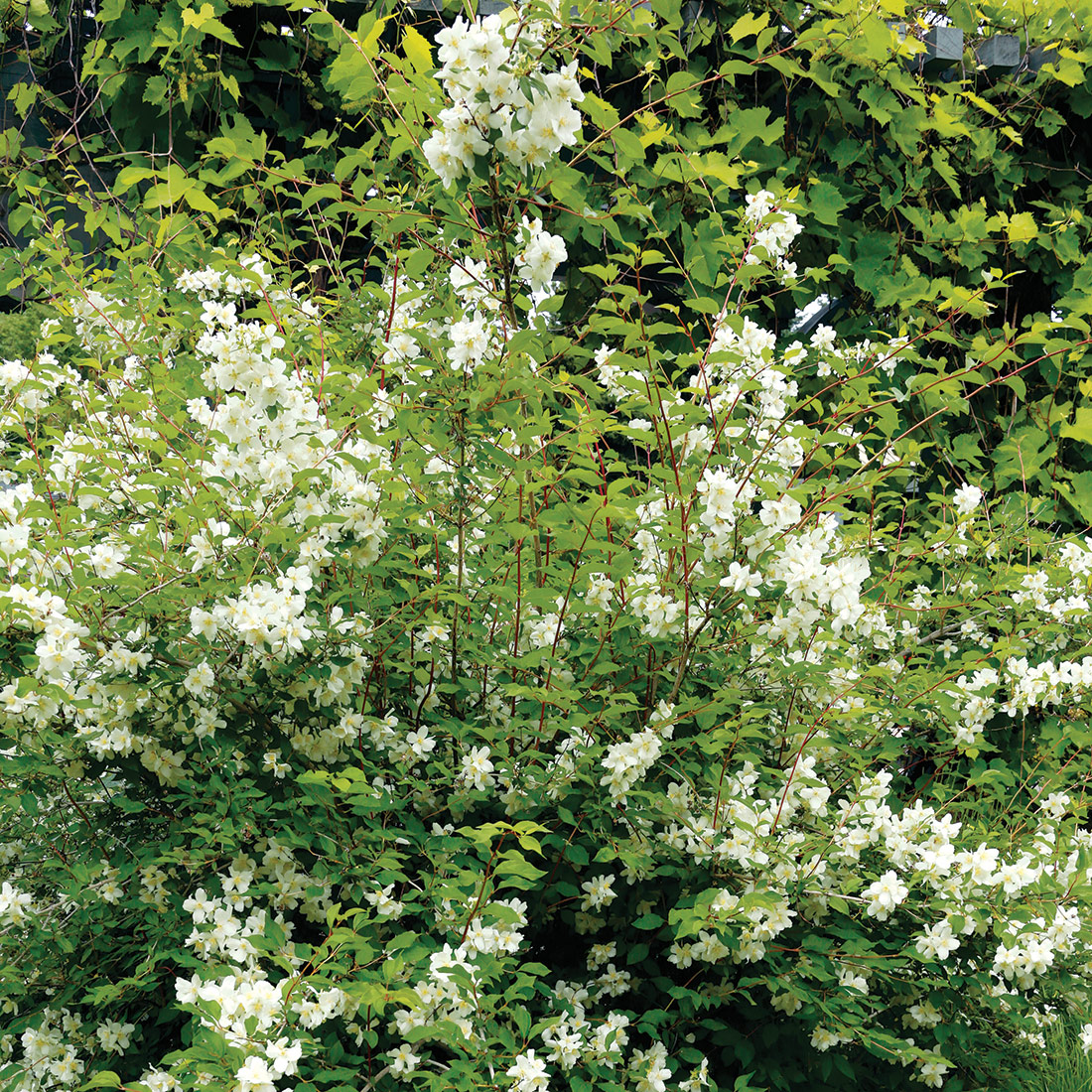
Name: Philadelphus lewisii ‘PWYO1S’
Zones: 3–9
Size: 6 to 9 feet tall and 5 to 8 feet wide
Conditions: Full sun to partial shade; medium to dry soil
Native range: Western U.S. and Canada
One of my favorite shrubs, this hardy cultivar was the only plant found blooming at the USDA Experimental Station in Cheyenne, Wyoming, after years of neglect. Pure white flowers with yellow centers cover it in late spring and continue throughout the summer. Their citrus scent is intoxicating. Oval, green leaves and a vase-like structure make this a great foundation plant that looks good in a mixed border as well. I’ve also seen it used as a hedge to provide some screening. Cheyenne® mock orange will tolerate xeric situations but will also take moderate water. It can get large with age but can be pruned after blooming to control its size a bit.
‘Mesa Verde’ Blue Spruce
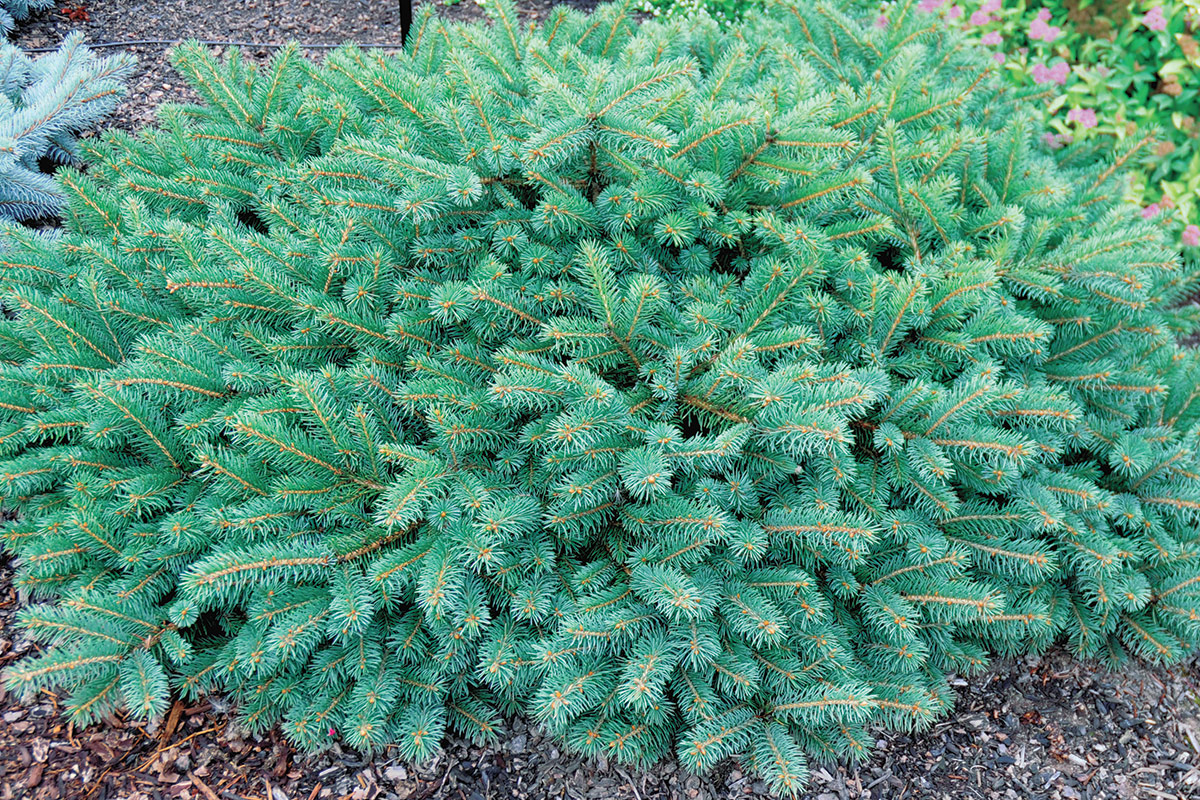
Name: Picea pungens ‘Mesa Verde’
Zones: 2–8
Size: 2 feet tall and up to 8 feet wide
Conditions: Full sun to partial shade; well-drained soil
Native range: North America
Not many spruces stay close to the ground, but ‘Mesa Verde’ is a beautiful exception. I’ve used this conifer to cover a gentle slope in my landscape due to it’s widely expanding habit. It also looks great in rock gardens. In addition to its short stature, this slow-growing variety has greener needles than most of its relatives, which tend to sport a blue cast. Like other spruces, ‘Mesa Verde’ requires minimal care with just occasional pruning for shape or to remove dieback.
Regional expert: Michelle Provaznik is the chief executive officer of the American Public Gardens Association and has been gardening in the Mountain West for over 20 years.
Midwest
‘Rooguchi’ Clematis
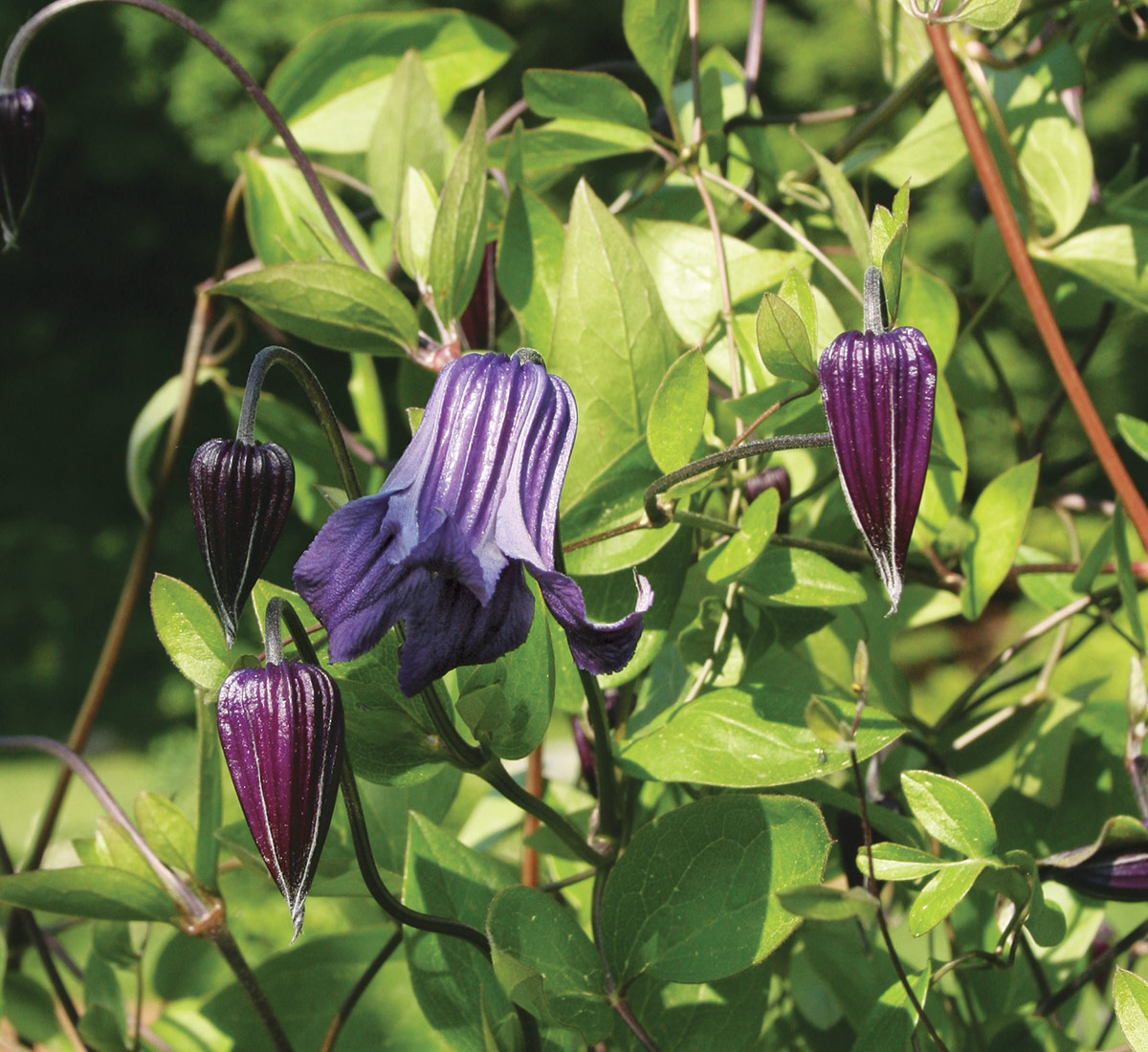
Name: Clematis ‘Rooguchi’
Zones: 4–9
Size: 6 to 8 feet tall and 3 to 4 feet wide
Conditions: Full sun; moist, well-drained soil
Native range: Hybrid
‘Rooguchi’ has the longest continuous bloom of any clematis I’m aware of. Last year mine was blooming by early May with its wonderful, downward-drooping, two-inch-long, violet-blue bells that recurve elegantly at the ends. And it flowered nonstop until the first hard frost. ‘Rooguchi’ is a hybrid between a shrub clematis and a vining type but is unique by not producing wraparound tendrils, so it’s not self-climbing. While it looks great clamoring over foundation shrubs, I like growing it up and through an obelisk. Corralling its width makes it a superb vertical specimen for blank walls. Be sure to plant it two inches deeper than the soil surface of its nursery pot, but never bury the fragile stems under mulch.
‘Blue Shadow’ Forthergilla
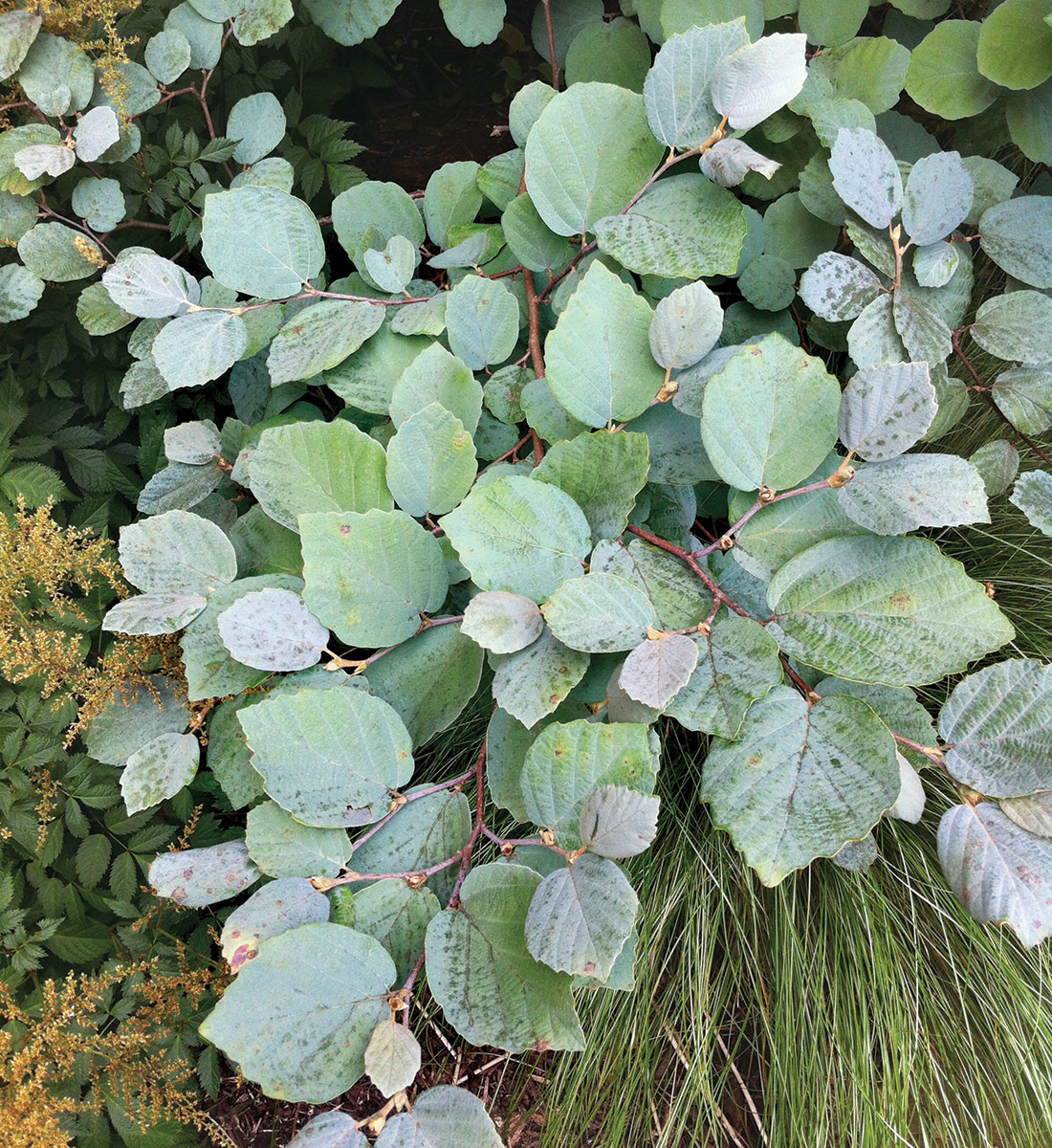
Name: Fothergilla x intermedia ‘Blue Shadow’
Zones: 4–8
Size: 4 to 5 feet tall and wide
Conditions: Full sun to partial shade; moist, acidic, well-drained soil
Native range: Hybrid of southeastern native
Don’t underestimate this shrub, because it has true multiseason appeal. In spring, precocious, fragrant honey-scented, white bottlebrush flowers emerge (bees love the early nectar), finishing just as the attractive oval leaves come out. The foliage possesses a handsome blue cast all season long until fall. What shrubs do you know that are powder blue? In autumn the leaves morph into a maroon, orange, yellow, or gold, depending on siting. With its oval silhouette it could be a specimen nestled near evergreens, or mass planted. The slow-to-moderate growth rate of ‘Blue Shadow’ fothergilla means no maintenance, and it’s an ideal candidate for shady foundations. While acidic soil is preferred, I’ve yet to notice issues in alkaline conditions.
Dwarf Columnar European Hornbeam
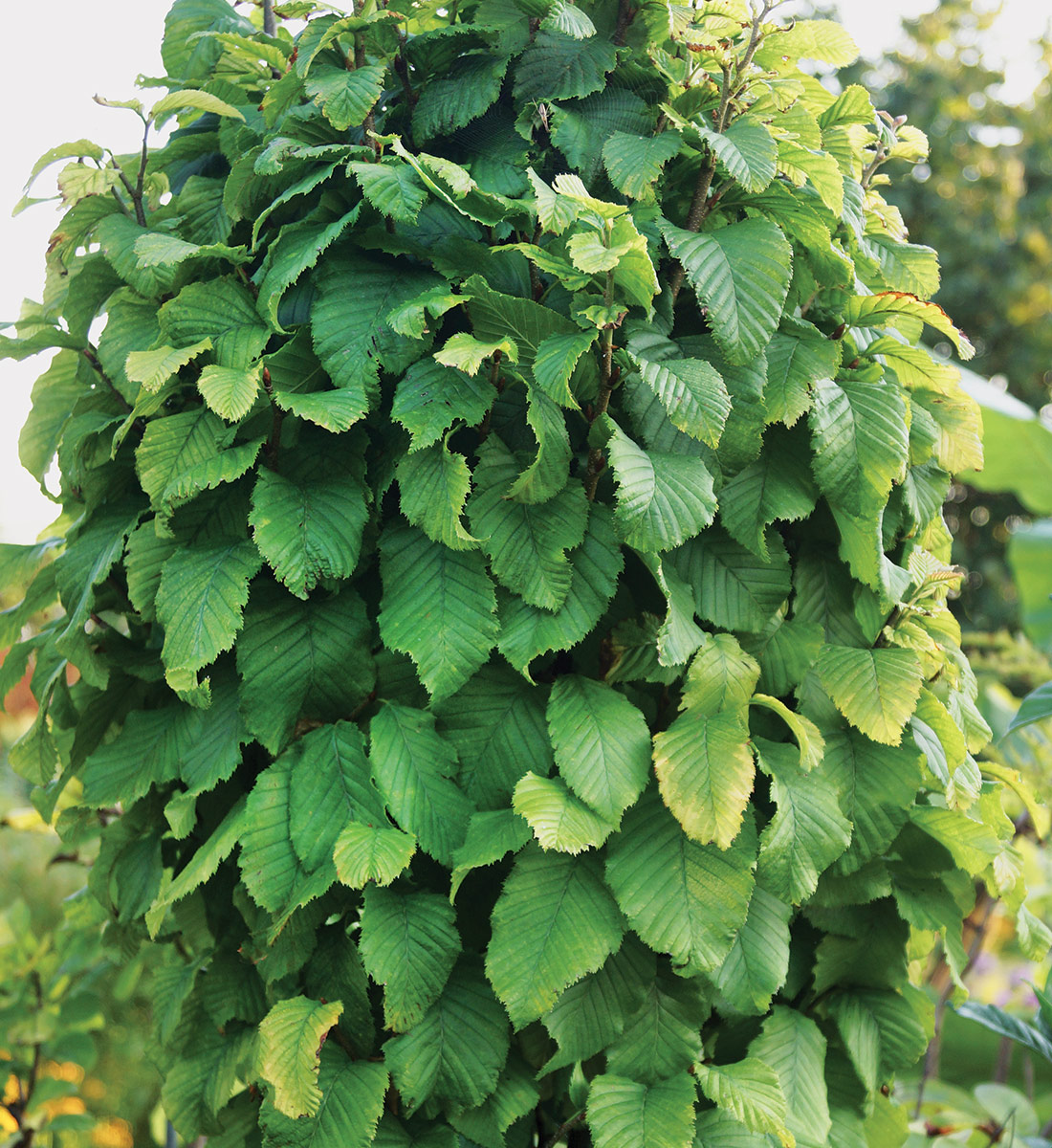
Name: Carpinus betulus ‘Columnaris Nana’
Zones: 4–8
Size: 6 to 8 feet tall and 3 to 4 feet wide
Conditions: Full sun to partial shade; well-drained soil
Native range: Europe, Asia
Everything about this very dwarf tree makes it a great front-of-house foundation candidate—either as a focal point, in a grouping, or even a formal hedge. It stands with a naturally dense, narrow silhouette, so even when bare in winter it has an architectural presence. The leaves are fine textured and a shiny medium green. Fall brings on a golden-yellow color, or if cooler weather comes suddenly, the foliage will often turn paper-bag brown and the tree will retain some of those leaves all winter. I like removing the lowest branches so that four to six inches of the smooth, gray-barked trunk is always showing. Dwarf columnar European hornbeam responds well to pruning, although that’s usually unnecessary because it is a super slow grower.
‘August Moon’ American Arborvitae
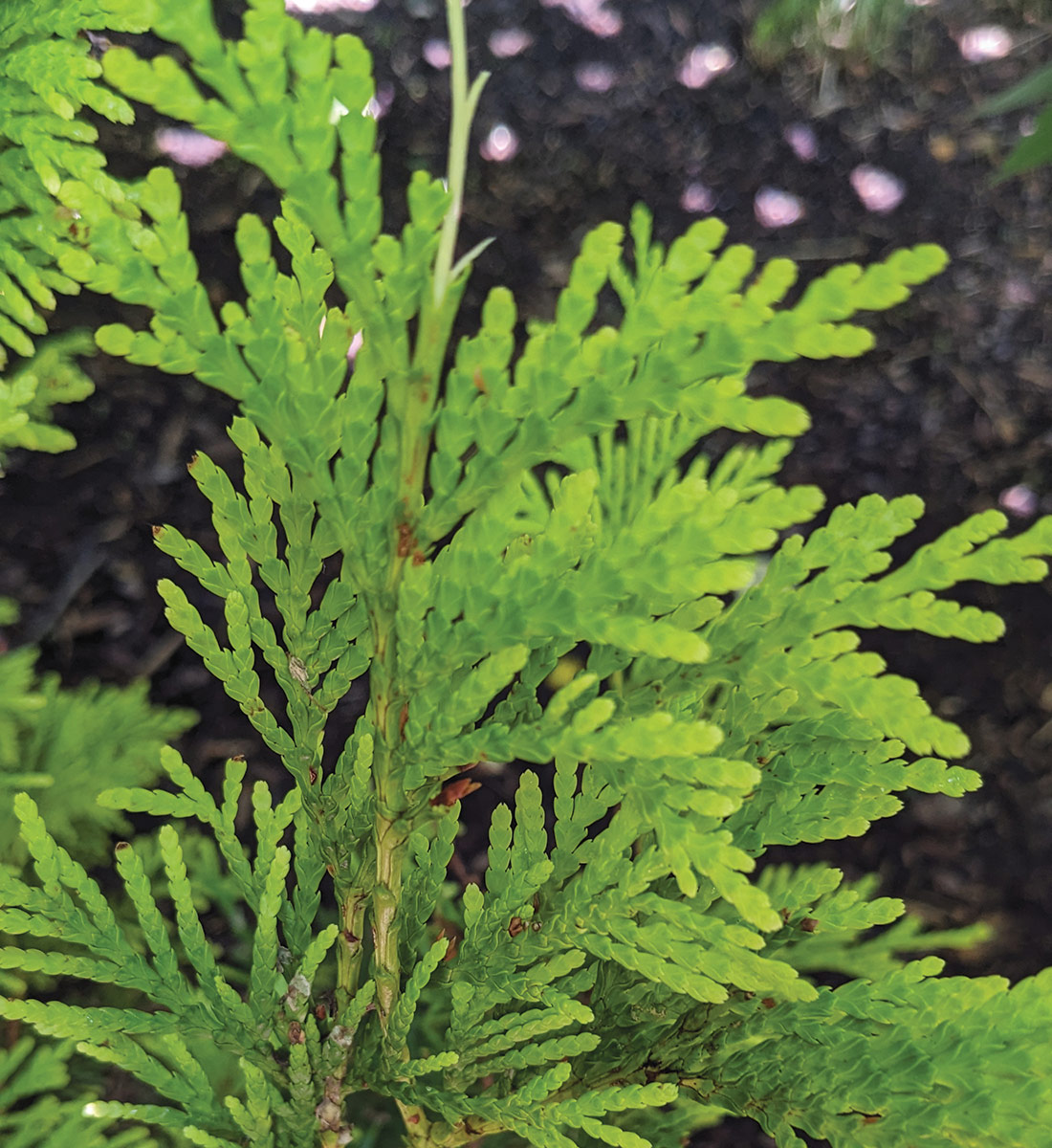
Name: Thuja occidentalis ‘August Moon’
Zones: 4–7
Size: 3 feet tall and wide
Conditions: Full sun; average soil
Native range: Cultivar of eastern U.S. native
Full disclosure: I saw and bought this stunning little dwarf conifer very recently when my plant-shopping karma was on fire! Who doesn’t like a strong but colorful bright yellow accent evergreen that never needs pruning? And the spring-yellow hue doesn’t change until the tips “bronze” with cold weather. My after-purchase research also indicates ‘August Moon’ is slow growing, with a two- to three-inch increase in height and spread per year. It’s purported to stay in a perfect globe without maturing into a cone shape. Perhaps consider this tidy little specimen as a substitute for the ubiquitous and blight-prone boxwood (Buxus spp. and cvs., Zones 5–9). Like most arborvitae, if you have deer, winter browsing can be an issue.
Regional expert: Tony Fulmer, a lifelong horticulturist, is the retired chief horticulture officer for Chalet, a specialty nursery in Wilmette, Illinois.
Southeast
Orion™ Star Anise
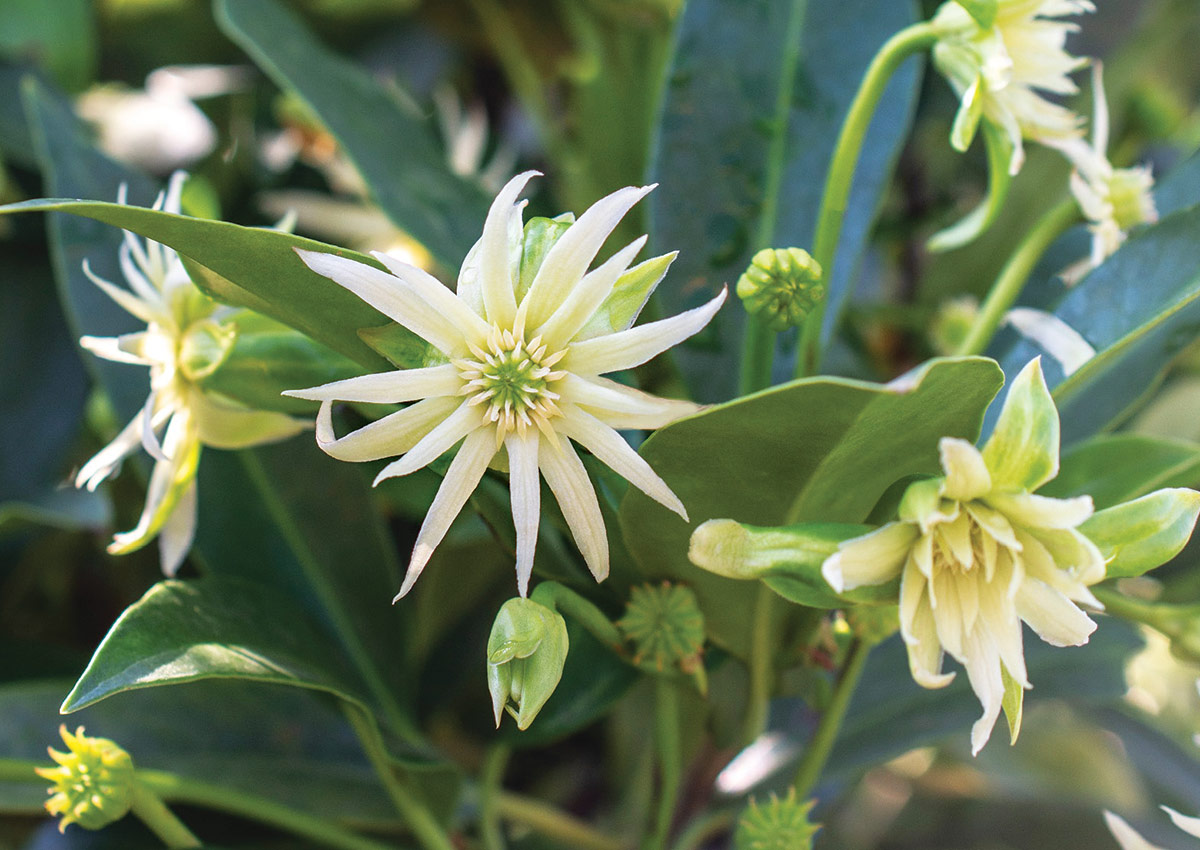
Name: Illicium ‘NCIH2’
Zones: 6–9
Size: 3 feet tall and 5 feet wide
Conditions: Partial shade; moist to wet soil
Native range: Hybrid of species native to the southern U.S. and Mexico
Illiciums are undervalued landscape plants, which is surprising considering their adaptability. They prefer partial shade, but also grow well in full shade and will tolerate full sun in the northernmost part of their range. Orion™ offers adaptability, disease resistance, and a short stature that makes it appropriate for planting underneath most windows. It resembles the overplanted ‘Otto Luyken’ cherry laurel (Prunus laurocerasus ‘Otto Luyken’, Zones 6–8), for which it is a worthy substitute. Deer tend to leave it alone, which is a definite selling point in my area. Its fragrant, star-shaped flowers are most abundant in mid-spring and fall but also appear sporadically throughout summer. Be aware that the foliage is toxic if consumed, and plant prudently.
‘Narihira’ Fernleaf Mahonia
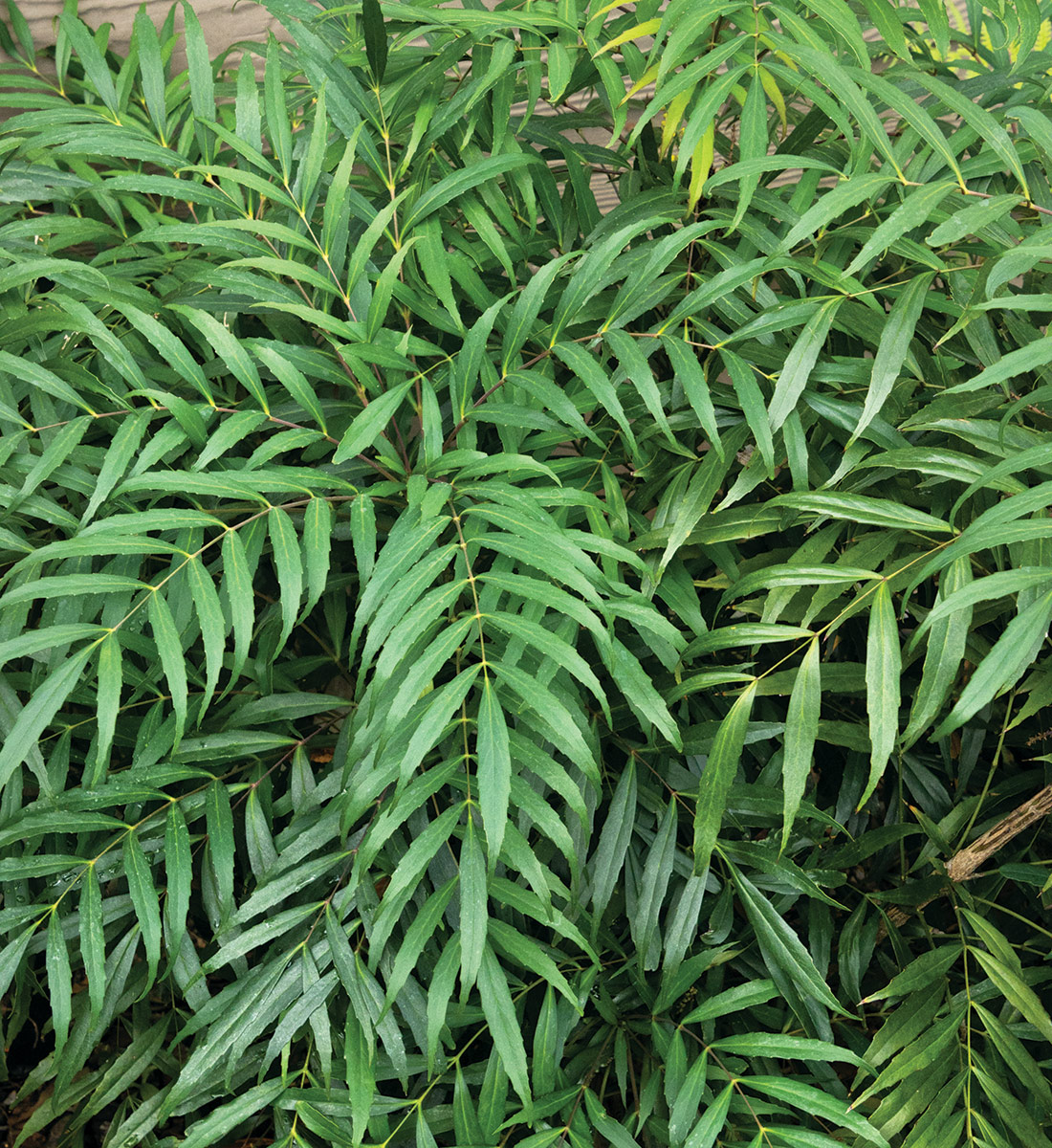
Name: Mahonia eurybracteata ‘Narihira’
Zones: 7–9
Size: 3 feet tall and wide
Conditions: Partial shade; average to moderately dry soil
Native range: China
This mahonia is a designer’s dream plant and somewhat hardier than the more common ‘Soft Caress’. It is sized appropriately for a foundation planting, needing little to no pruning. Small, somewhat fragrant, yellow flowers clustered on six-inch spikes open in mid to late winter, when very little else is blooming. But my favorite thing about this shrub is its narrow, fernlike foliage. It is the perfect foil for large-leafed companions like hostas (Hosta spp. and cvs., Zones 3–9), which share its affinity for light shade, or morning sun with afternoon shade. Creating these juxtaposed garden vignettes will take your design to the next level. Be advised that winter burn can be a problem in cooler zones, particularly in severe winter weather.
Wedding Gown™ Bigleaf Hydrangea
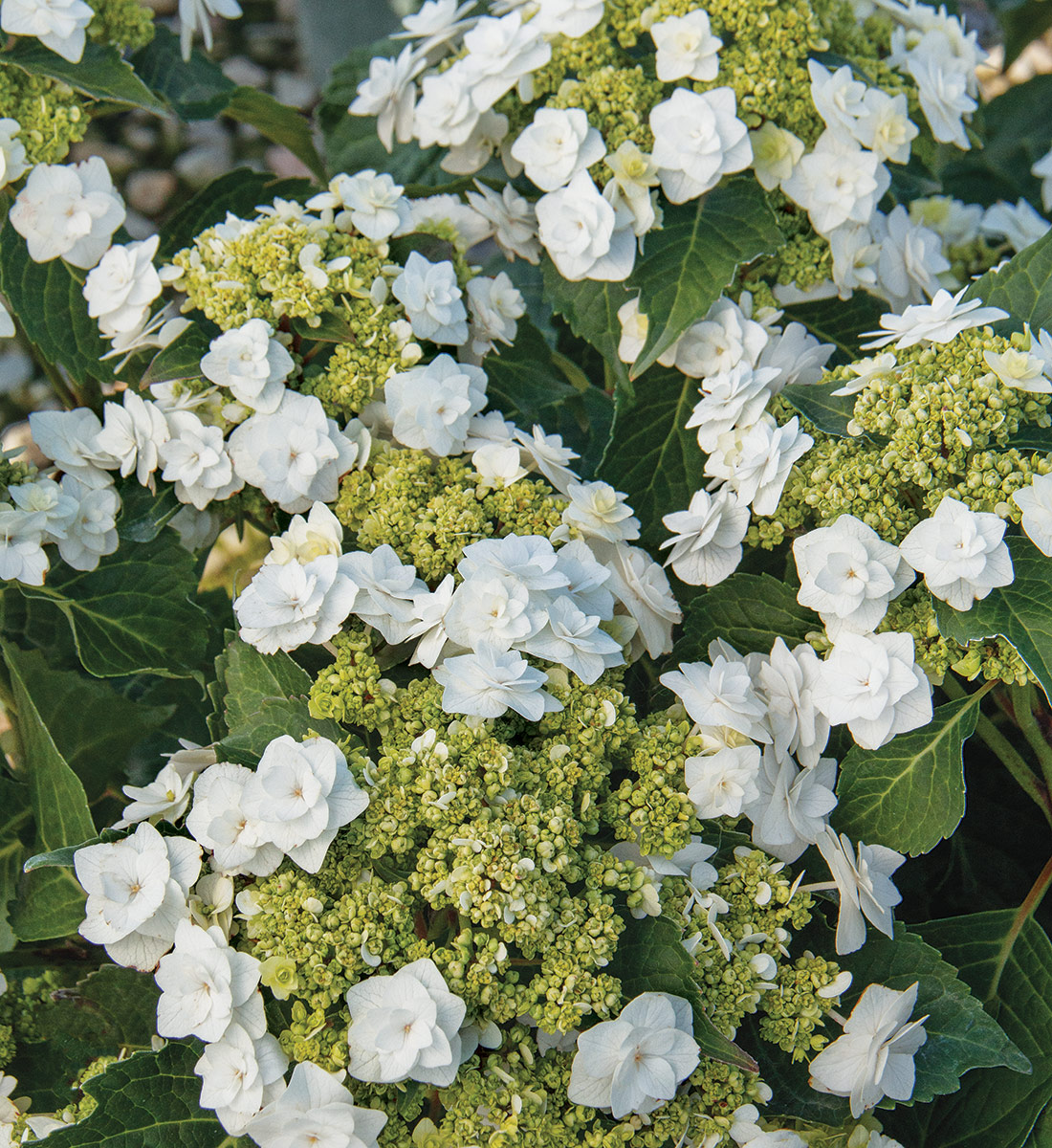
Name: Hydrangea macrophylla ‘Dancing Snow’
Zones: 5–9
Size: 2 to 3 feet tall and 3 to 5 feet wide
Conditions: Partial shade; moist, well-drained soil.
Native range: East Asia
Wedding Gown™ is my favorite hydrangea. Its exquisite double flowers arrive in mid-spring, and it will rebloom through summer and into autumn. The pure white flower color is not affected by soil pH. It is short and compact, never lanky, so it’s perfect next to walkways or under windows. Like other H. macrophylla, it is deciduous, so I always plant something low and evergreen in front of it, or taller and evergreen behind it when using it in a foundation planting. Give it a spot in light shade or morning sun with afternoon shade in more southern locales, and watch it perform like a true star. Consistently moist, well-drained soil is the key to success, and remember that more hydrangeas are killed by overwatering than by underwatering.
Sweet & Lo™ Sweet Box

Name: Sarcococca hookeriana ‘Purplerij1’
Zones: 5–9
Size: 18 to 30 inches tall and 24 to 36 inches wide
Conditions: Partial to full shade; average to rich, well-drained soil
Native range: China and eastern
Tibet Sweet boxes are underused in Southeastern gardens. This newer cultivar features fragrant clusters of small, hot-pink-and-white blooms in late winter and early spring. These are favorites of early-emerging pollinators. Sweet & Lo™ has a mounding habit and sports dark green evergreen foliage. Its short stature makes it perfect for planting underneath low windows. This shrub has a light suckering habit, which makes a suitable ground cover over time. It could be combined with Wedding Gown™ bigleaf hydrangea for a dazzling long season of flowers, lighting up a shady foundation garden.
Regional expert: Jay Sifford is an award-winning garden designer, writer, and speaker based in Charlotte, North Carolina.
Mid-Atlantic
‘Brandywine’ Foamflower
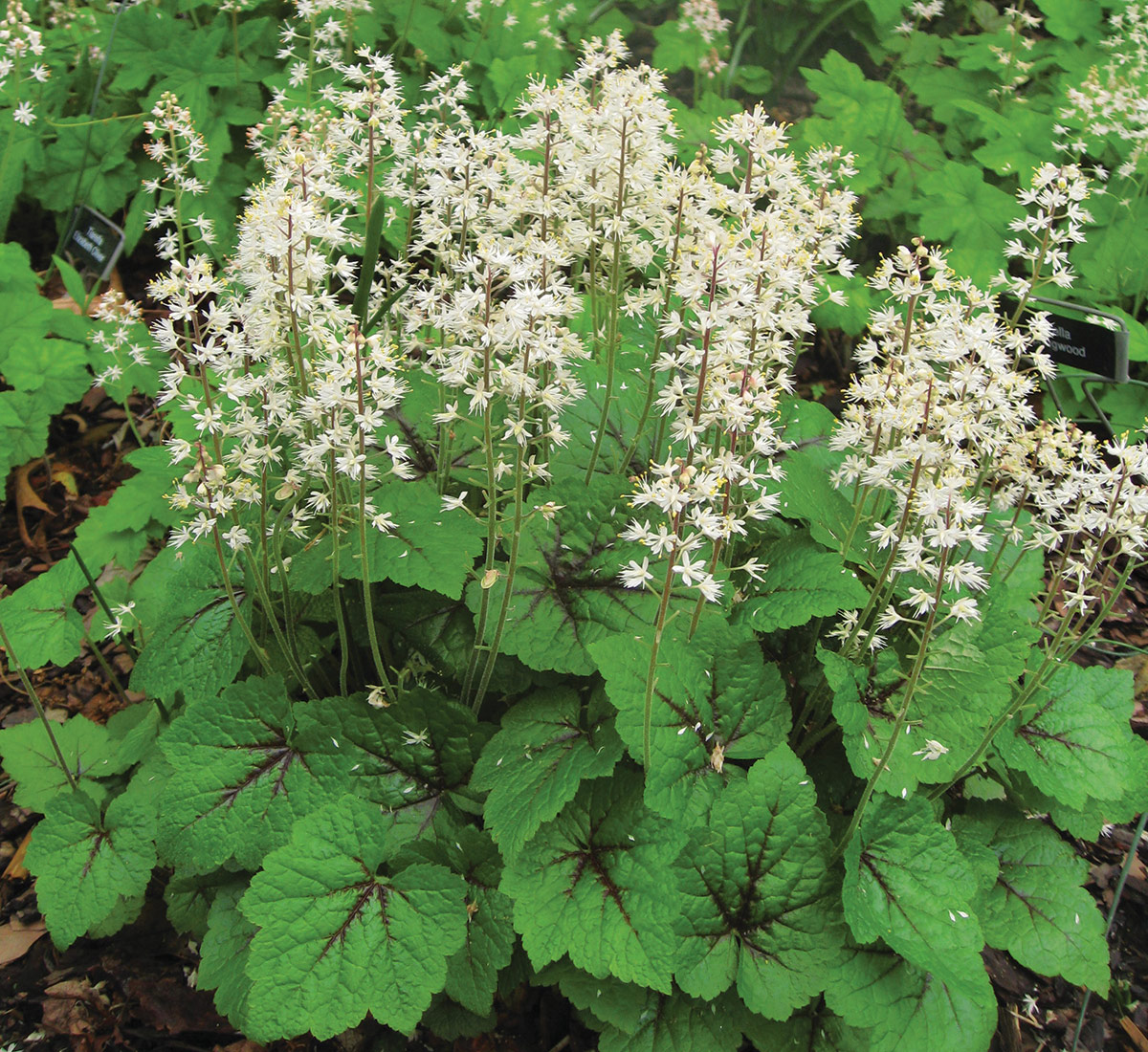
Name: Tiarella cordifolia ‘Brandywine’
Zones: 4–9
Size: 6 to 12 inches tall and 12 to 24 inches wide
Conditions: Partial to full shade; moist, well-drained soil
Native range: Eastern North America
This clump-forming native ground cover works great around a shaded foundation without smothering it. ‘Brandywine’ foamflower has refined foliage and bottlebrush-shaped flowers. The fuzzy racemes rise around eight inches above the leaves and are very showy in spring with an extended bloom period. The stalks have a pink cast, which contrast with the lightly scented white blossoms. When planted en masse, these blooms look like fog rising through mountains. ‘Brandywine’ foliage emerges from a low-mounded basal rosette. It’s painted maroon along the midrib and has long petioles that remain through winter. When established, this plant is tolerant of a variety of soils, including dry shade.
Dwarf Elkhorn Cedar

Name: Thujopsis dolabrata ‘Nana’
Zones: 6–9
Size: 2 to 4 feet tall and 4 to 6 feet wide
Conditions: Full sun to partial shade; moist, well-drained soil
Native range: Central Japan
Dwarf elkhorn cedar is a slow-growing, shrubby version of the much larger straight species. Its compact, rounded form is wider than it is tall, and slightly flat on top, like a steamed bun. The arborvitae-like foliage is a rich, glossy chartreuse green, making its overall appearance lush and robust. The undersides of the foliage are bright white, which can be seen every time a breeze moves through the branches, and the leaves can also take on an orange-bronze hue in winter. This evergreen is deer resistant and tolerates shade while keeping its dense form. Its layered texture is coarser than that of most dwarf conifers, making it deserving of wider usage. Provide it with evenly moist, rich, and acidic soil for best results.
‘Pee Wee’ Oakleaf Hydrangea
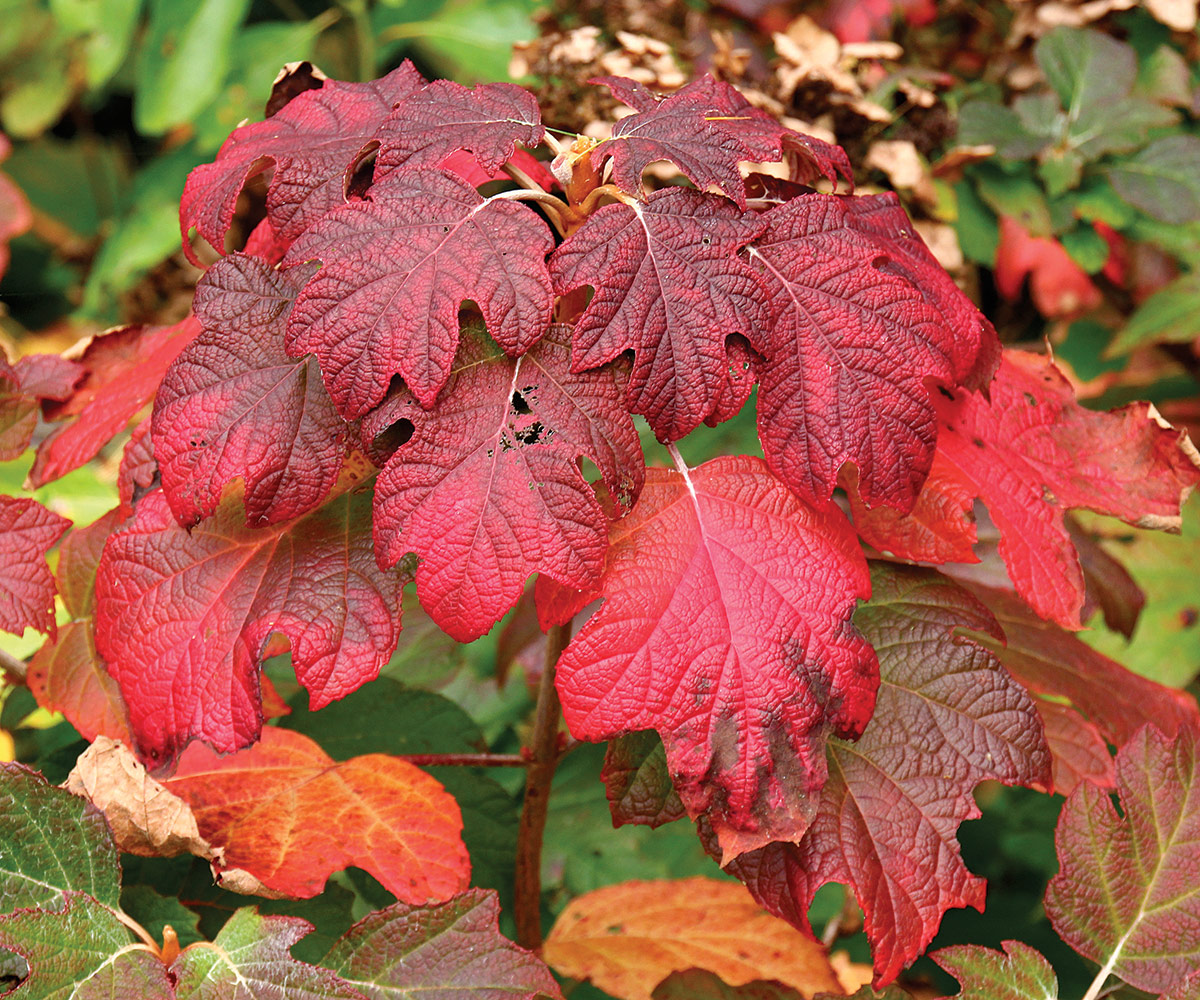
Name: Hydrangea quercifolia ‘Pee Wee’
Zones: 5–9
Size: 3 to 5 feet tall and wide
Conditions: Full sun to partial shade; well-drained soil
Native range: Southeastern United States
This cultivar packs the four-season interest of oakleaf hydrangea into a compact form. Bold-textured, dark green foliage acts as a backdrop to upright, cone-shaped flower panicles that cover the shrub in late spring. The dense panicles of white blooms have sterile bracts that fade to pink in summer. This shrub’s fall foliage color is bright red to deep merlot (pictured), with exfoliating cinnamon bark seen in winter. With interior branching that’s wide and sturdy like antlers, ‘Pee Wee’ is easy to prune and shape as desired. This native deciduous shrub prefers a slightly sheltered location, making it ideal along a foundation’s edge. It also works as an accent plant near a front door, where it will wow at any time of year.
‘Transparent’ Purple Moor Grass
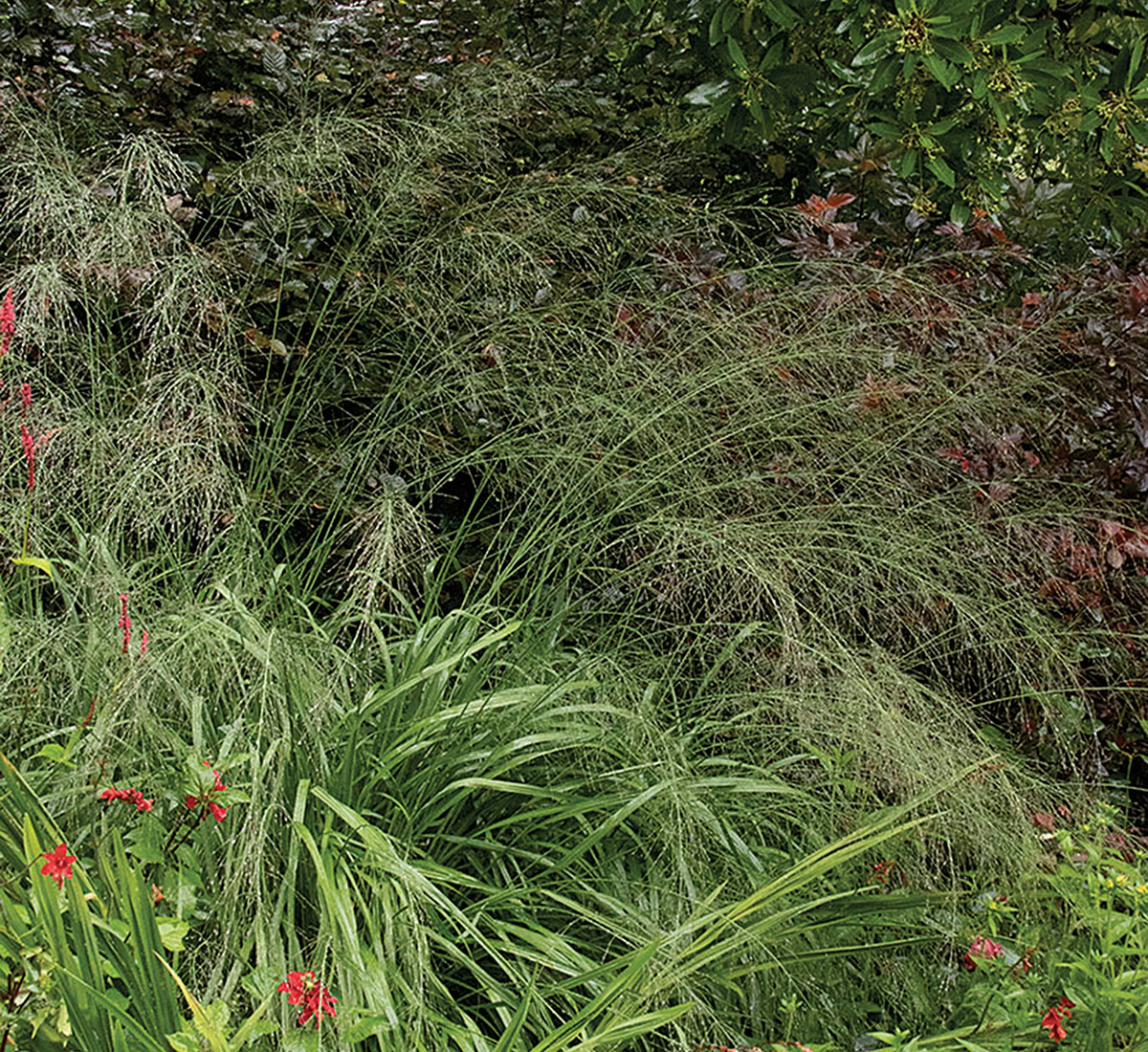
Name: Molinia caerulea subsp. arundinacea ‘Transparent’
Zones: 4–8
Size: 5 to 7 feet tall and 2 to 3 feet wide
Conditions: Full sun to partial shade; well-drained soil
Native range: Europe, Asia, and northern Africa
The graceful form of this tall, fine-textured ornamental grass has see-through panicles. Its low foliage and light, airy plumes allow it to cover the front of a house without obscuring windows. ‘Transparent’ purple moor grass is clump forming, producing upright flower plumes that reach high above the foliage and calmly sway in the wind. The mound of leaves is olive green, sometimes with a bluish cast. It turns golden in fall, while the sturdy plumes remain upright through winter. Cut back the foliage to the ground in early spring to make way for new growth. ‘Transparent’ looks great set against a dark background, or backlit in the sunlight. It can hold its own as a specimen, but it looks even more dramatic planted in a line.
Regional expert: David Mattern is a horticulturist at Chanticleer, a public garden in Wayne, Pennsylvania. He documents his garden journey on Instagram @matternii.
Northeast
‘Midwinter Fire’ Bloodtwig Dogwood
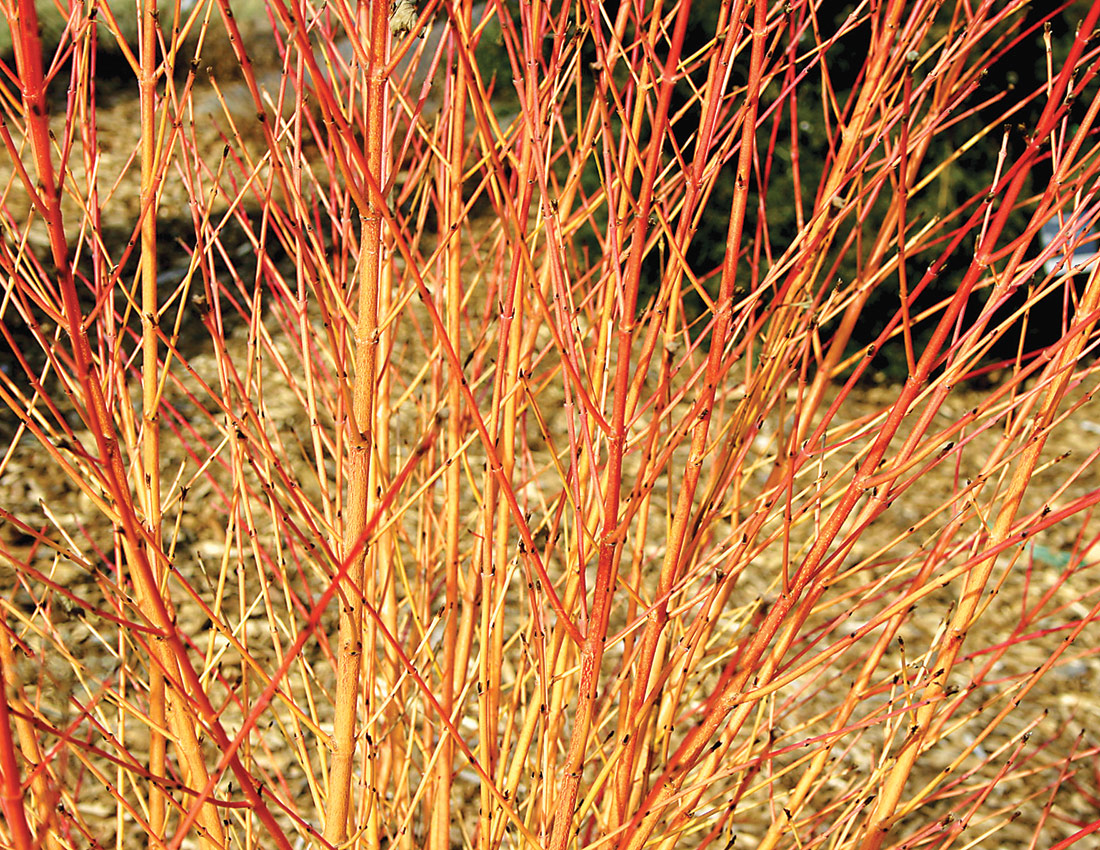
Name: Cornus sanguinea ‘Midwinter Fire’
Zones: 5–7
Size: 5 to 6 feet tall and wide
Conditions: Full sun to partial shade; rich, moist, well-drained soil
Native range: Northern Europe, northwestern Asia
You could choose this shrub for the white flower clusters that attract pollinators in spring or the dark purple fruit that birds flock to in summer. The foliage, too, is plenty handsome, particularly when it brightens to yellow in fall. But I guarantee, it’ll be the bare naked, glowing gold stems with red tips that you’ll look forward to the most, even if winter is your least favorite season. Spotlight them by planting ‘Midwinter Fire’ in full sun against a dark backdrop. After the shrub has been planted for about three years, start pruning a few of the oldest stems close to the ground in early spring to encourage a fresh crop of winter-vivid whips. Remove suckers as they poke up unless space allows for a spreading colony.
‘Blue Shag’ Eastern White Pine
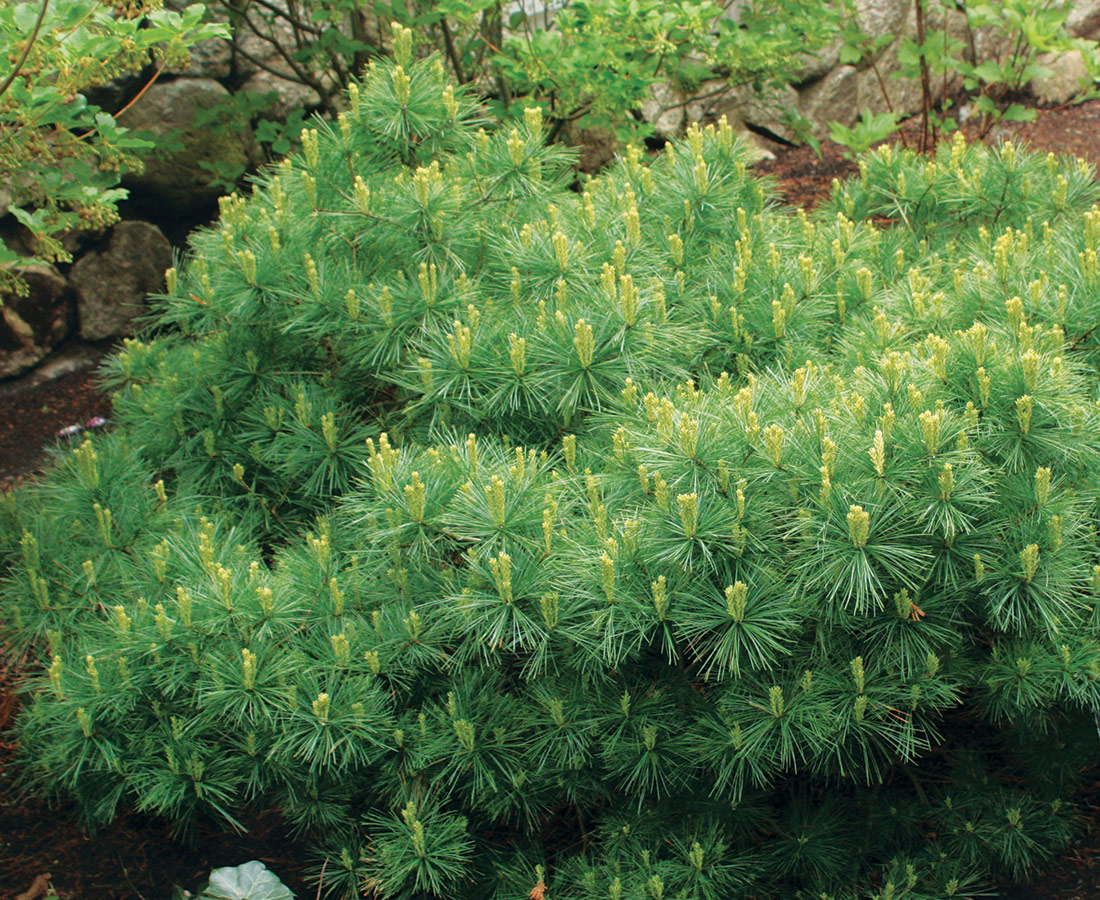
Name: Pinus strobus ‘Blue Shag’
Zones: 3–8
Size: 2 to 4 feet tall and 3 to 4 feet wide
Conditions: Full sun to partial shade; acidic, moist, well-drained soil
Native range: Northeastern North America
This pine’s cuteness is undeniable. Plump sets of feather-soft, blue needles form a roly-poly muffin that flickers with pale green candles of new growth in spring. This tree is a slow grower that will take years to bulge up and out to its full height and girth. Pruning is entirely optional. The previous season’s needles shed from the interior in fall; tidying up by combing them out with your fingers is gratifying but not necessary. As with many Northeast natives, ‘Blue Shag’ prefers acidic soil but tolerates some sweetness typical of beds close to concrete foundations. To prevent stress during droughts, provide additional irrigation and add a layer of shredded leaf mulch along with the tree’s own shed needles to help hold moisture and enrich the soil.
‘Color Guard’ Yucca
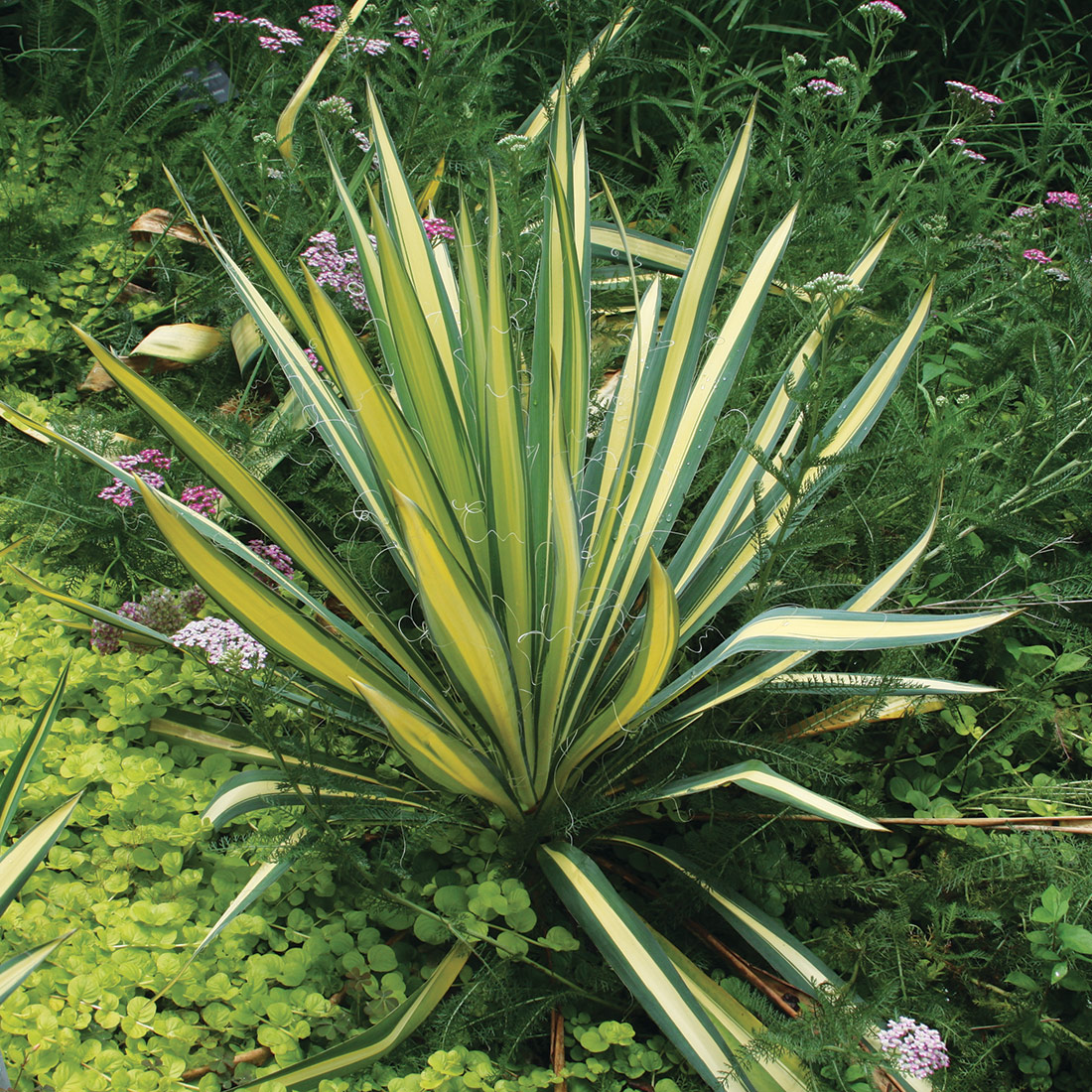
Name: Yucca filamentosa ‘Color Guard’
Zones: 4–10
Size: 2 to 3 feet tall and wide; 6 feet tall in bloom
Conditions: Full sun to partial shade; average to dry, well-drained soil
Native range: Southeastern U.S.
Like me, you might associate yuccas with neglected properties and sharp pokes in the eye. But ‘Color Guard’ is not your everyday parking lot plant. True, it thrives in terrible soil, as long as it’s well-draining. It takes beating sun, road salt, wind, humidity, and other insults on the chin. However, its sunshine-bright, sword-shaped foliage is a striking textural complement to every other garden companion. These leaves are also soft enough for a gardener to safely weed around. And, come midsummer, the stupendous, hummingbird-magnet, creamy white bell flowers stand to remind us why even the straight species is garden-worthy. Even so, to keep ‘Color Guard’ colorful, remove any foliage or pups that revert to green.
‘Bevan’s Variety’ Bigroot Geranium
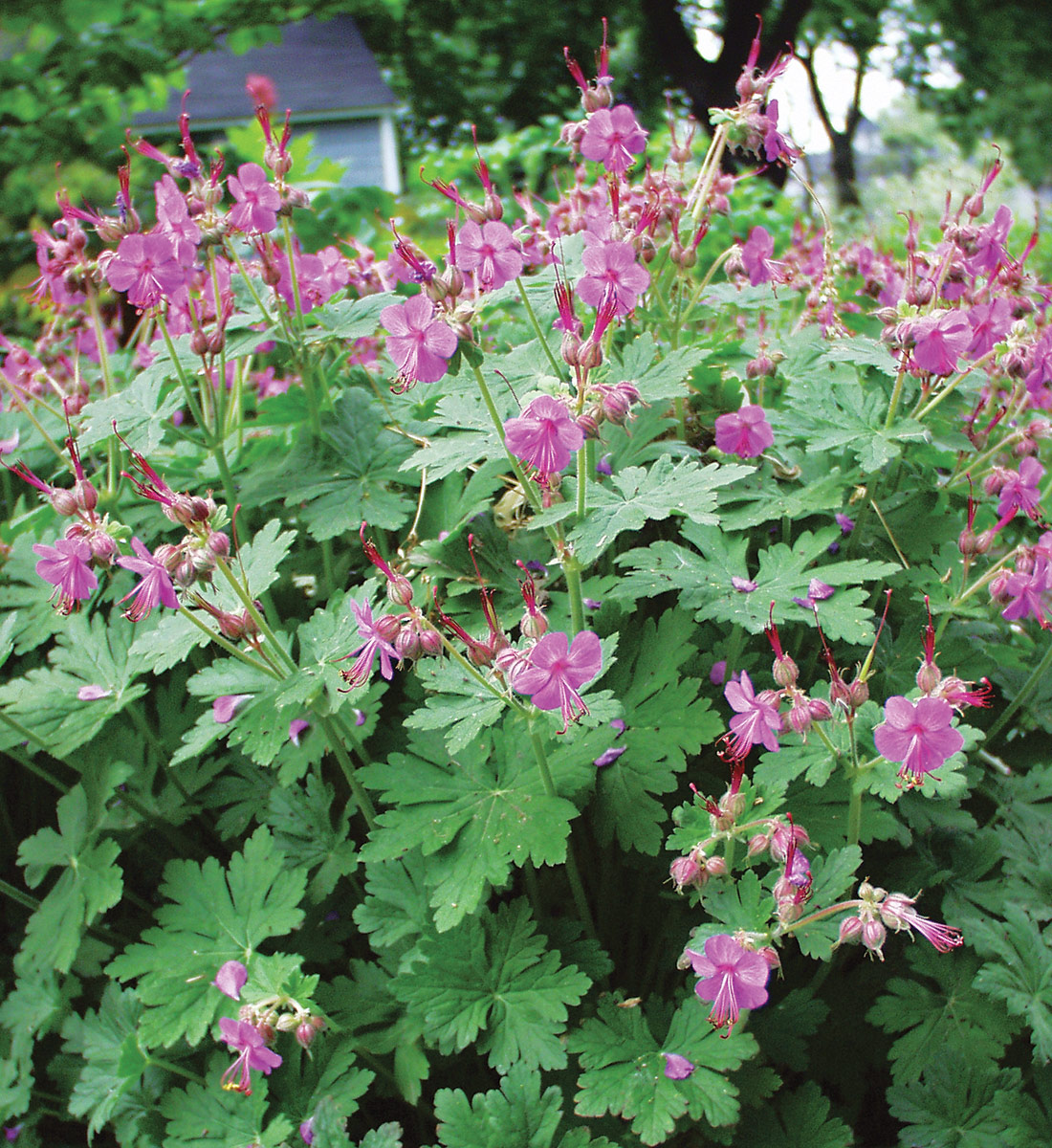
Name: Geranium macrorrhizum ‘Bevan’s Variety’
Zones: 3–8
Size: 8 to 12 inches tall and 18 to 24 inches wide
Conditions: Full sun to partial shade; dry to average, well-drained soil
Native range: Central and southeastern Europe
Why spread a layer of bark to suppress weeds when a ground-covering plant will do the job as effectively and much more beautifully? ‘Bevan’s Variety’ spreads via thick rhizomes to form a sweater of moleskine-soft, semievergreen foliage that turns red in fall. Magenta flowers hover over it in spring. To add to its appeal as a living mulch, it has the holy grail of dry shade, drought, and humidity tolerance—and it’s also low-maintenance. I groom spent flower stems and faded leaves more to release the aromatic oils, which make it deer and rabbit resistant, than for the sake of tidiness. To encourage faster spreading, divide clumps in spring or fall. Broken rhizomes root easily.
Regional expert: Kristin Green is the author of Plantiful: Start Small, Grow Big With 150 Plants That Spread, Self-Sow, and Overwinter. She gardens in Bristol, Rhode Island.
Regional expert photos: courtesy of the contributors.
Fine Gardening Recommended Products

DeWalt Variable-Speed Cordless Reciprocating Saw
You can fit a variety of blades to this saw to cut fallen branches or prune larger limbs from trees in a pinch. It’s fast, tough, easy to use, and extremely versatile.
– 18.31 x 6.13 x 4 inches
– 1-1/8-inch stroke length
– Variable speed trigger with 0-3000 spm

DeWalt Variable-Speed Cordless Reciprocating Saw with 6-Piece Saw Blade Set
You can fit a variety of blades to this saw to cut fallen branches or prune larger limbs from trees in a pinch. It’s fast, tough, easy to use, and extremely versatile.
– 18.31 x 6.13 x 4 inches
– 1-1/8-inch stroke length
– Variable speed trigger with 0-3000 spm
– DW4856 Metal/Woodcutting Reciprocating Saw Blade Set, 6-Piece

Black and Decker 22-inch Cordless Hedge Trimmer
Quick and easy to put into operation and is less noisy and lighter in weight than gas-powered hedge trimmers.
– 38 x 7 x 7 inches
– 6.9 pounds
– 1 Lithium Ion battery required (included)







